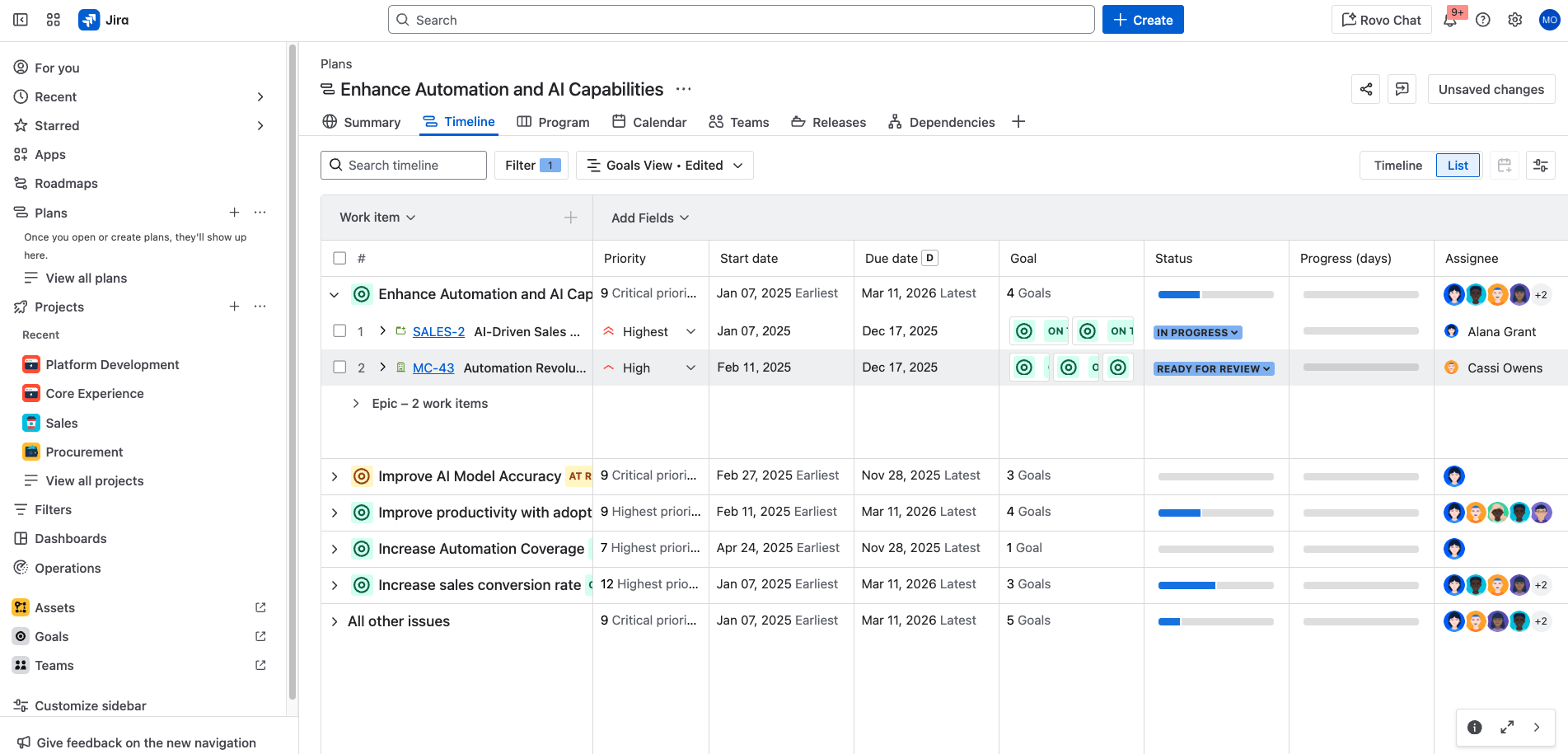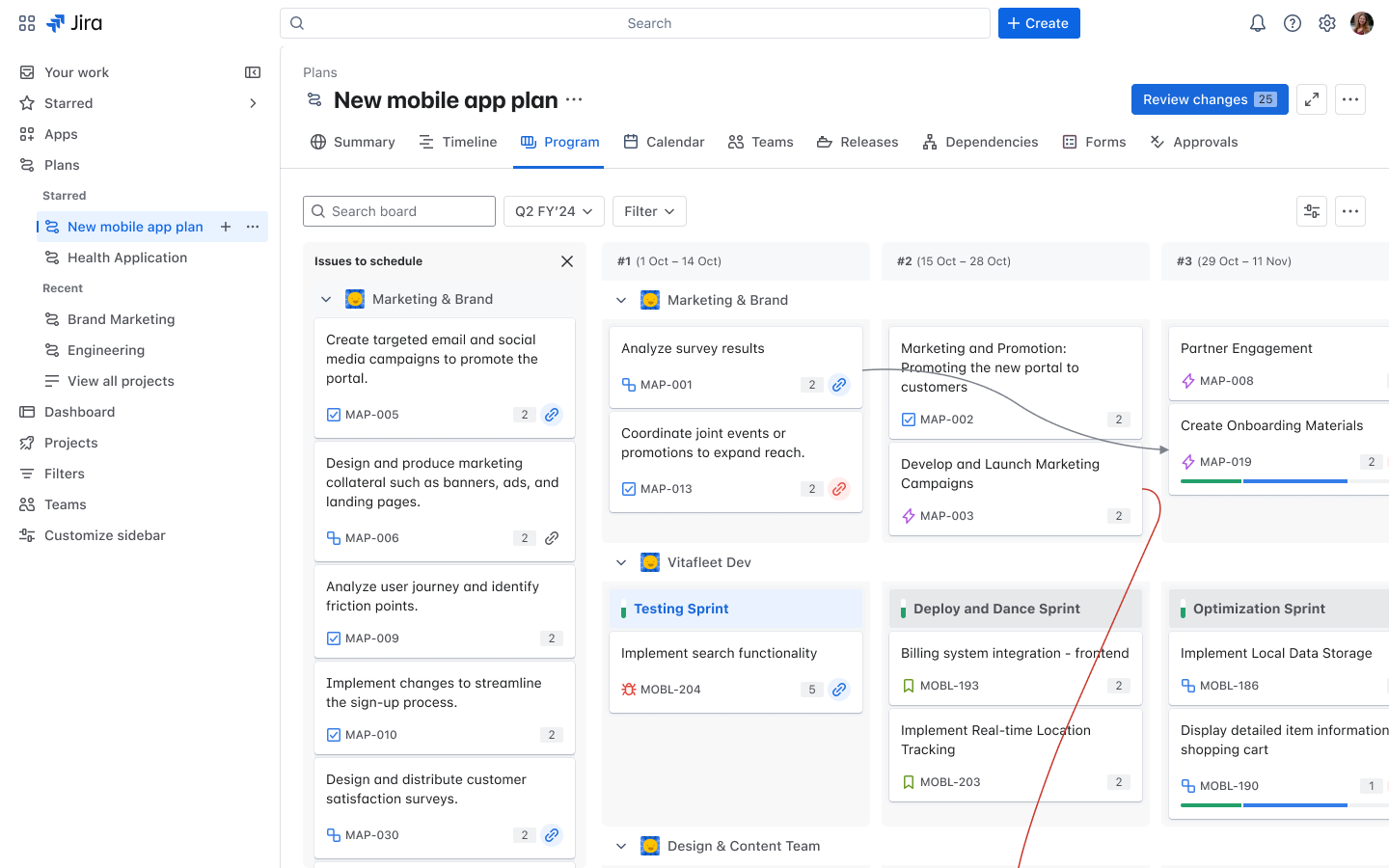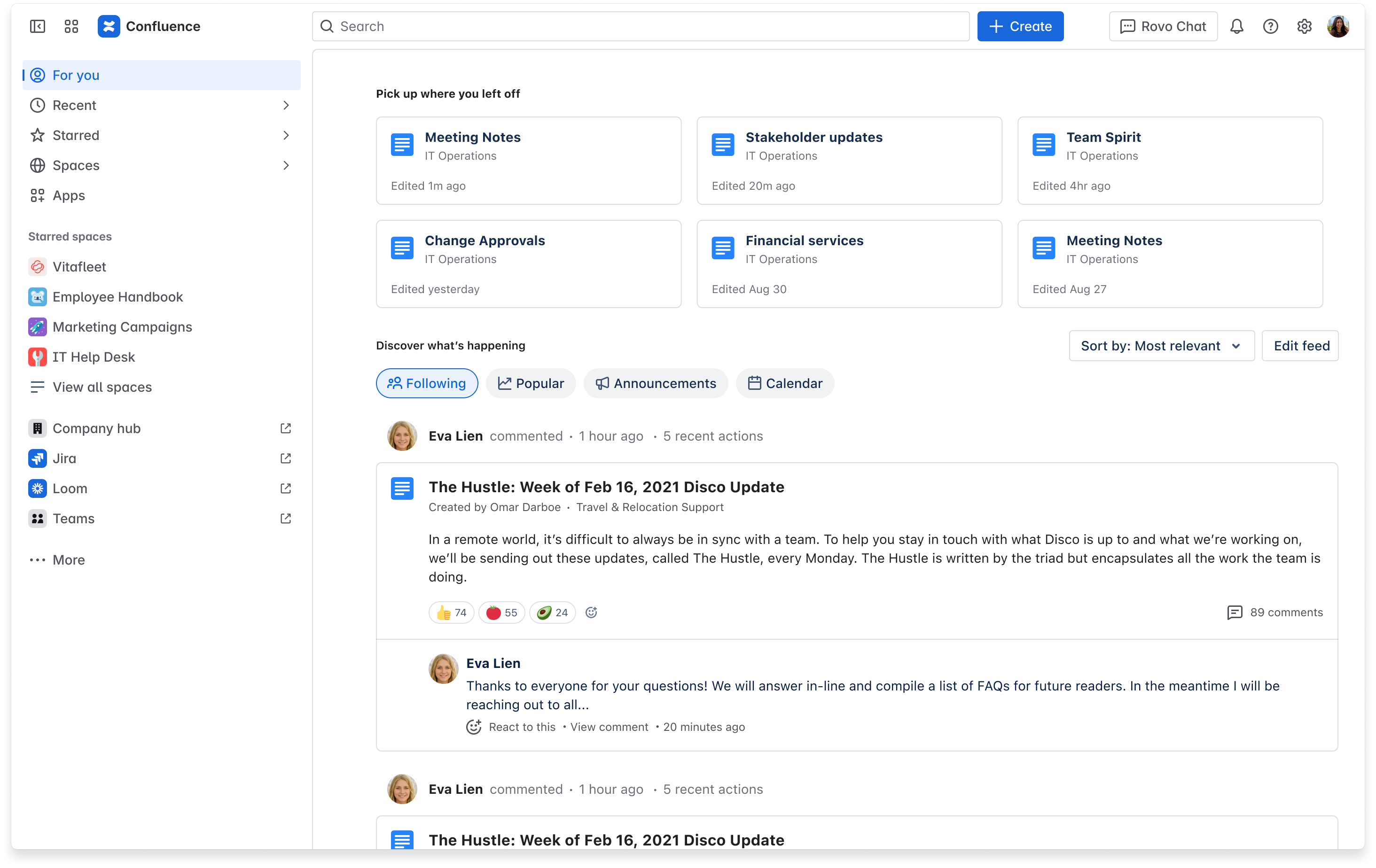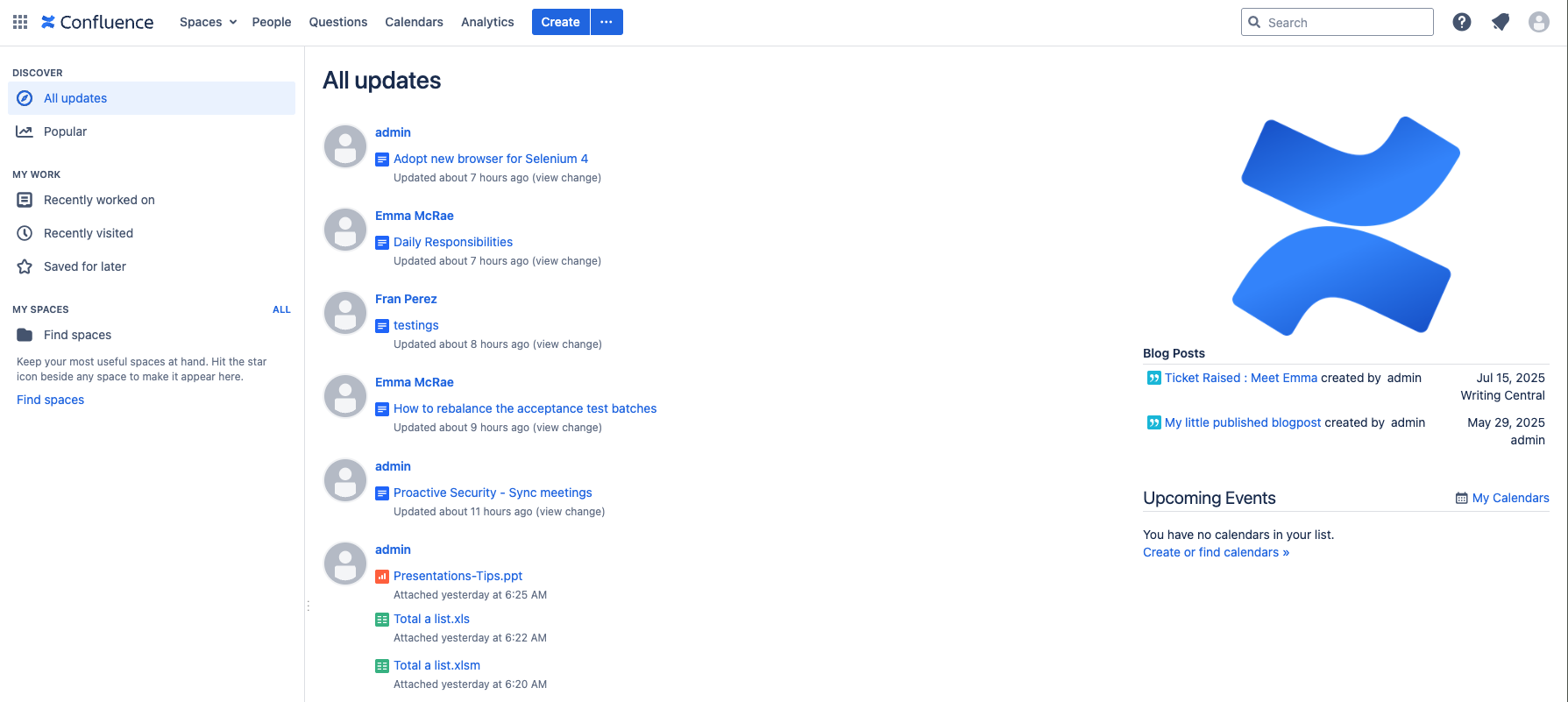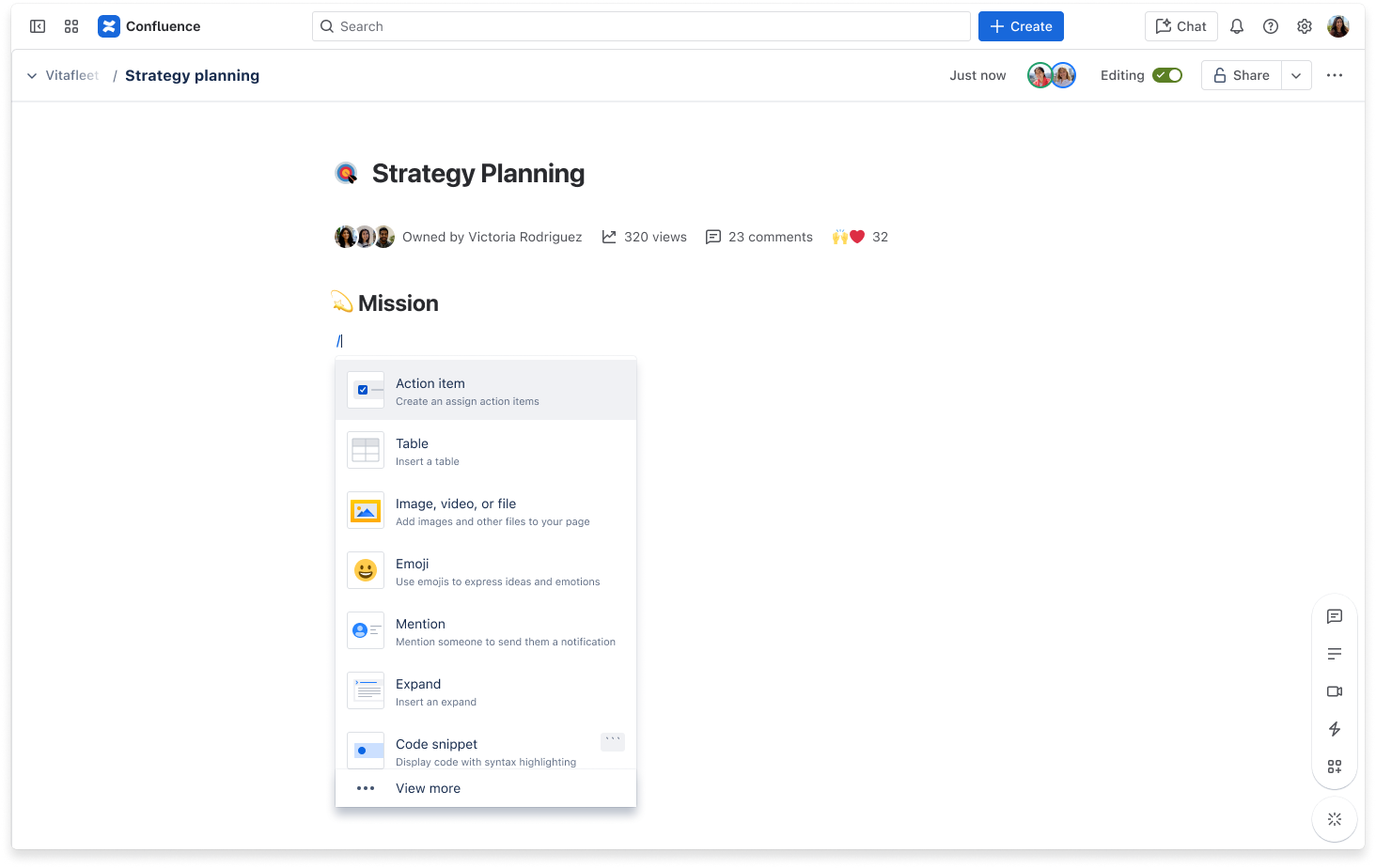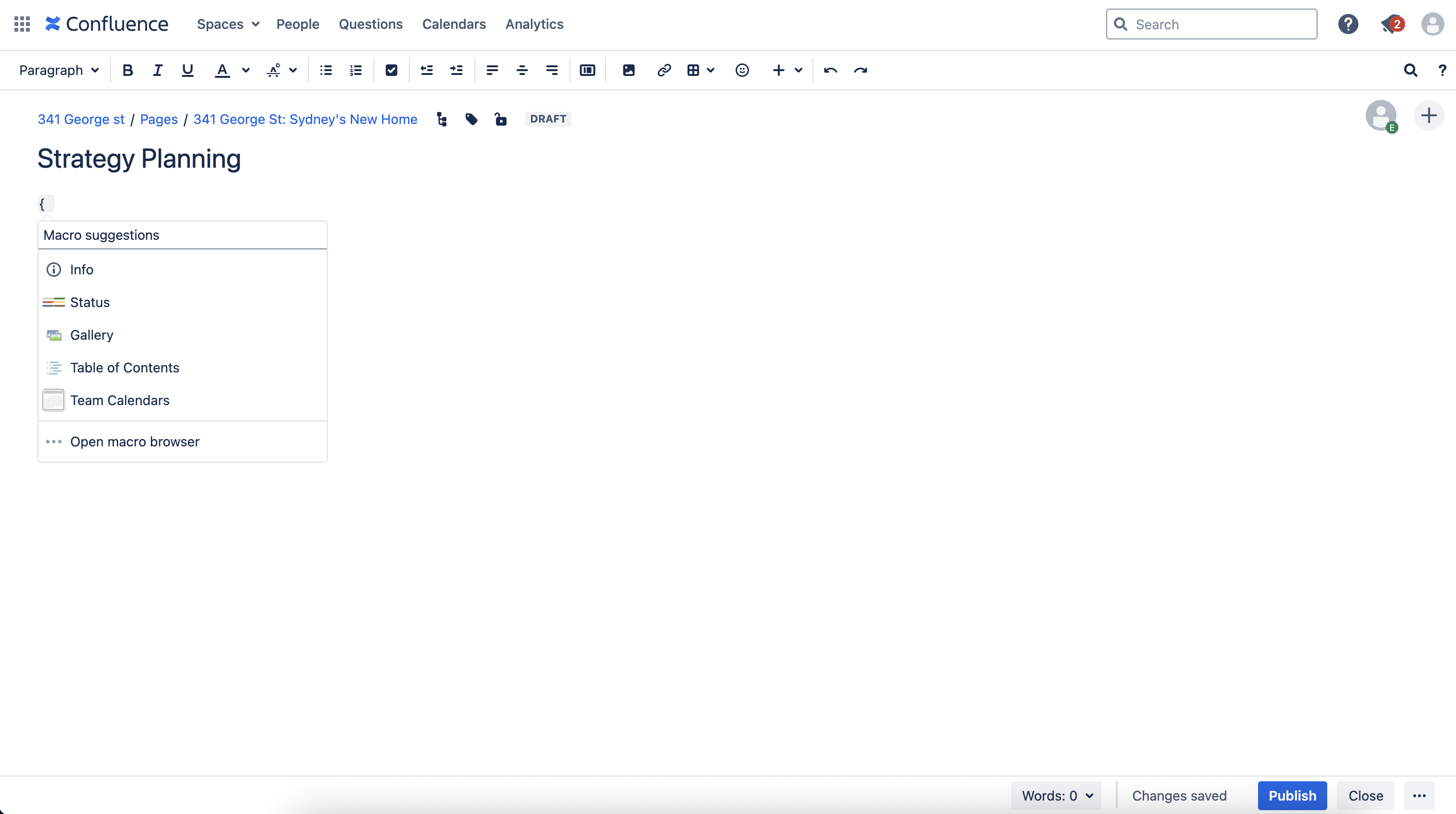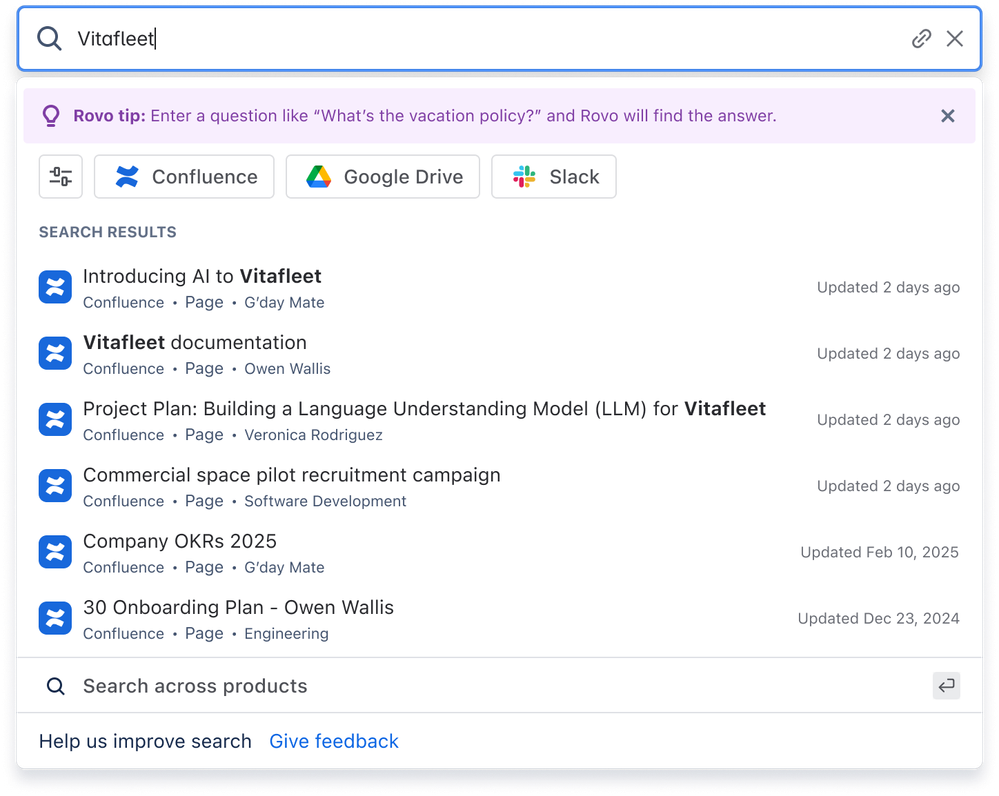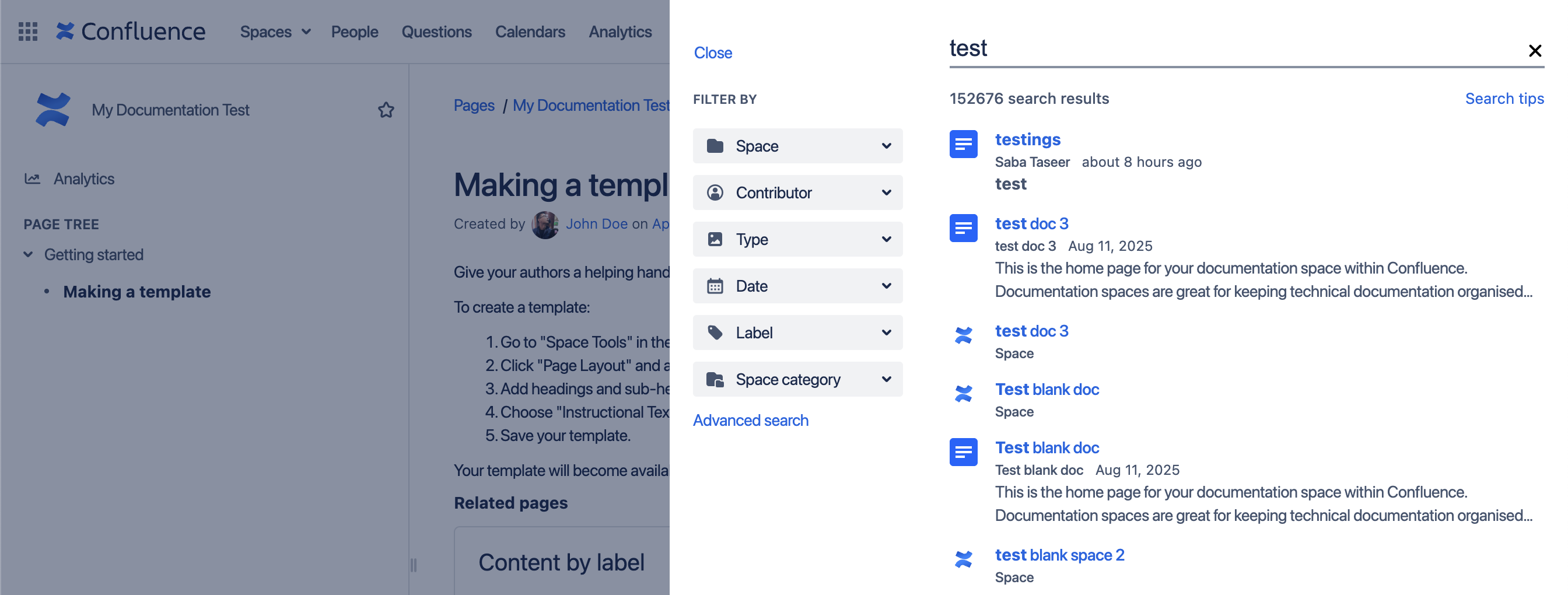Cloud Adoption Toolkit
A guide outlining key UX differences users can expect with the move to cloud so admins can prepare teams for the change ahead
Setting your users up for success in Atlassian Cloud
At Atlassian, we often say that cloud migrations are a team sport. It takes a powerhouse group of people to execute a large-scale transformation like a migration. And, if we extend the team sport metaphor, the final phase of a migration - helping your users learn how to be productive on a new platform - is the fourth quarter. That’s when your team’s preparedness and endurance really pay off.
Executing a great change management and adoption plan is critical when you’ve invested so much work into the technical aspects of the migration. It’s tempting to hope your users will adopt your new cloud apps organically, but just like a great sports team, the best migration teams don’t leave the final stretch to chance. To realize the full ROI of your move to Atlassian Cloud, you need to focus time and energy on ensuring your teams embrace new ways of working across the Atlassian Cloud Platform.
Many of your users have likely been using Atlassian Data Center products for years, which means making the switch to Atlassian Cloud can require some adjustment.
This guide is designed to give admins like yourself a practical resource for helping your users transition smoothly and seamlessly to adopt Atlassian Cloud. It does this by outlining key changes in the user experience from data center to cloud, along with providing tips, examples, and resources you can share. Rather than covering every possible difference, it highlights the most important changes your users will notice right away, so you can prepare them for a confident start. If you're looking for major functional differences and specific comparisons for admins, see the cloud and data center comparison page for a summary.
Throughout this guide, we’ll link to other helpful resources, including ones you can share directly with your users. Our goal is to help you minimize disruption, deflect questions from your support queues, and get your teams productive on Atlassian Cloud apps as quickly as possible.
TIP: To stay informed about new features, releases, and updated time frames for Atlassian Cloud apps:
- Sign up for weekly email updates on the Atlassian blog. Just click the Watch icon to subscribe when logged in.
- Subscribe to the cloud roadmap to receive quarterly highlights, empowering you to proactively prepare for upcoming changes and stay informed about the latest app developments.
NOTE: You can copy and paste from this guide to create customized training materials. If you do, we recommend substituting screenshots from your organization’s instances so they are familiar to your users.
Accessing your Atlassian Cloud site
All users will have a new cloud site URL to access their Atlassian apps. Unlike in data center, where there are different base URLs for each app, in cloud, the URL base is the same across apps with an added suffix:
- Confluence: https://yourdomain.atlassian.net/confluence/home
- Jira and Jira Service Management: https://yourdomain.atlassian.net/jira/your-work
TIP: To help redirect people from your self-managed instance to your new cloud site URL, apply a site-wide banner in the self-managed versions of Jira and/or Confluence and/or add an announcement in Jira Service Management. If users have bookmarked their pages, remind them to update their bookmarks with the new cloud links.
What about mobile access?
The mobile apps for Jira Cloud and Confluence Cloud are distinct downloads. If your teams are using the data center mobile app for these apps, they’ll need to install new apps for Jira Cloud (for Jira and Jira Service Management) and Confluence Cloud
Mobile policy (also known as Mobile Application Management – or MAM) is available for both managed and unmanaged users as a part of an Atlassian Guard subscription which comes with the Atlassian Cloud Enterprise plan. Mobile Device Management (MDM) is available with all cloud plans.
What about Rovo access?
Rovo, Atlassian’s AI-powered offering, is included for all eligible Standard, Premium, and Enterprise plans of Jira, Confluence, Jira Service Management, and the Teamwork Collection of apps.
Powered by the Teamwork Graph, Rovo delivers relevant answers and detailed insights driven by your team’s knowledge, while also protecting data privacy and security every step of the way. Data never leaves your Atlassian environment, and admins control which apps and connectors are enabled. You can access Rovo capabilities through:
- Rovo Search: Surface relevant information quickly and efficiently from across your Atlassian Cloud and connected third party apps, all in one place.
- Rovo Chat: Accelerate learning with personalized insights and answers through a conversational interface.
- Rovo Agents: Work faster and smarter with agents that are seamlessly integrated into Atlassian Cloud. Agents have specific skills, map to every type of workflow, and take action in partnership with human teammates.
- Rovo Studio: Quickly build everything from AI agents to automation and apps in one unified experience - with or without code.
How new users can get value from Rovo right away:
- Accelerate onboarding and adoption: Ask Rovo for help, definitions, guidance, and much more to reduce ramp-up time and support tickets.
- Break down silos: Connects knowledge across cloud apps, making it easier to find answers and collaborate with others.
- Boost productivity: Automate repetitive tasks, get instant summaries, and surface the right information at the right time.
Admin controls
Admins can manage Rovo and AI-enabled app preferences under ‘Settings’ in Atlassian Administration. You can enable and disable Rovo and AI for specific apps, and if needed, restrict AI features for sensitive spaces or teams.
By seamlessly surfacing your data and processes across Atlassian Cloud, Rovo helps every team move faster, solve problems more effectively, and make smarter decisions.
Learn more about Rovo through these resources:
TIP: Encourage your new users to explore Rovo Chat and Search to get onboarded faster, resolve setup issues, learn new cloud features, and uncover insights across their work.
Key differences in Jira Cloud
General user interface and navigation
We designed the cloud platform to be more intuitive for all of your users - not just developers. We’ve found some of these changes to the core experiences are easier for users to navigate independently.
Cloud has a different sidebar and horizontal navigation from data center. You’ll see the same main navigation bar across all Jira Cloud apps. This gives you quick access to the spaces (previously called ‘projects’), filters, and dashboards you use most. It also lets you create work items (previously called issues), search and chat using Rovo, and access help notifications and global Jira settings.
Use the diagram below to familiarize yourself with the navigation bar for all Jira Cloud apps:
NOTE: Depending on the Jira app and app version, the navigation bar options may vary slightly.
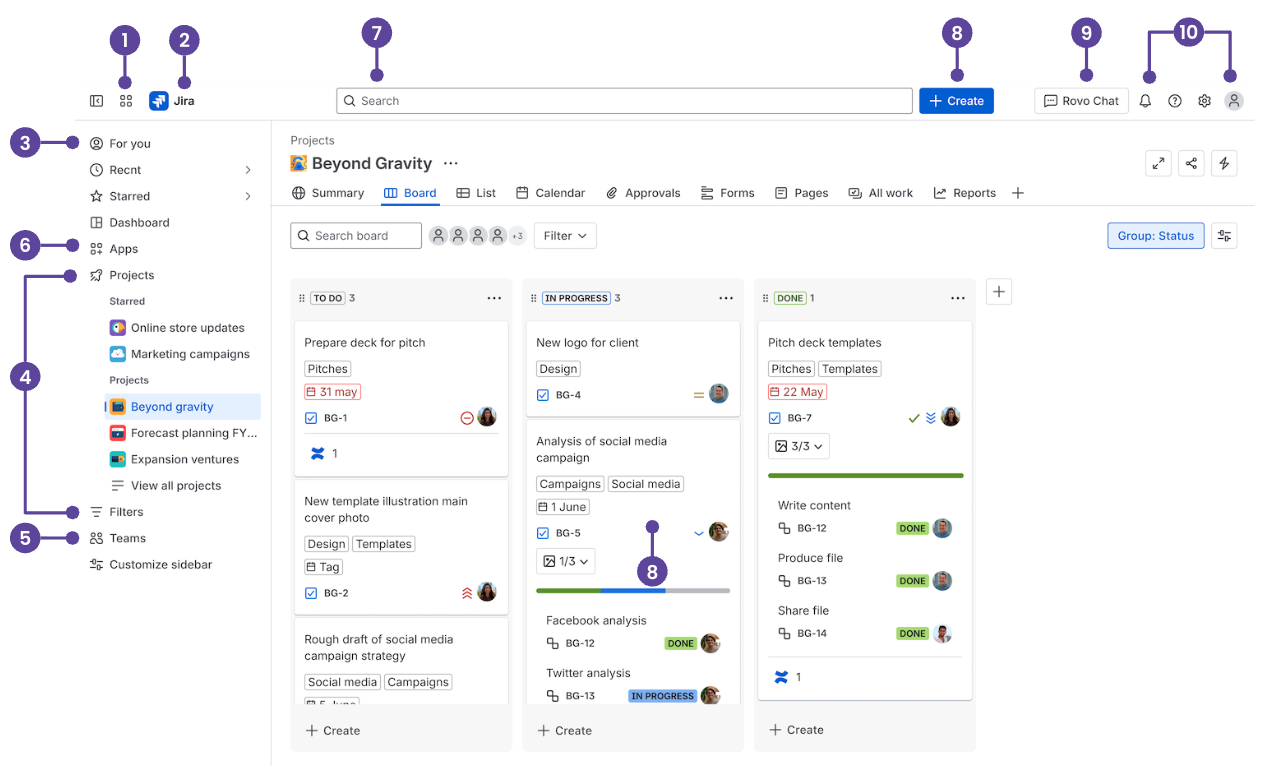
- App switcher: Switch between Atlassian and third-party apps, like Confluence, Talent, and Miro, or go to other sites.
- Jira logo: Keep track of which Atlassian app you're in as you switch between apps. Use this logo to navigate back to your homepage from any page.
- For you: Get an overview of the things you care most about in Jira. Find work items, spaces, boards, and queues you’ve visited, work assigned to you, and your starred items.
- Spaces, Filters, Dashboards, and more: Quickly find and resume work on the things you use most. Your starred items appear at the top of each menu, followed by your recently visited items.
- Teams: See the people and teams you work with, and create new teams.
- Apps: See and manage marketplace apps installed on your Jira site.
- Search: Find work items, spaces, boards, queues, filters and people. If enabled, paid editions get AI-powered, cross-app search via Rovo.
- Create: Create work items easily from anywhere within Jira.
- Rovo Chat: Ask questions and explore your company’s knowledge through an AI-powered chat interface. Rovo chat is available on paid editions and must be enabled by admins.
- Notifications, Help, Settings, and your profile: See what's happening in Jira, get help, and customize Jira’s settings (Jira admins only) and your personal settings.
For more details, see the Jira Cloud navigation page.
Where did the work items dropdown go?
You’ll most likely notice that cloud doesn’t have a dropdown for work items. Instead, your recent activity will appear in the ‘For you’ section on the sidebar. Filters are now a separate menu item and work items can be reached via the sidebar.
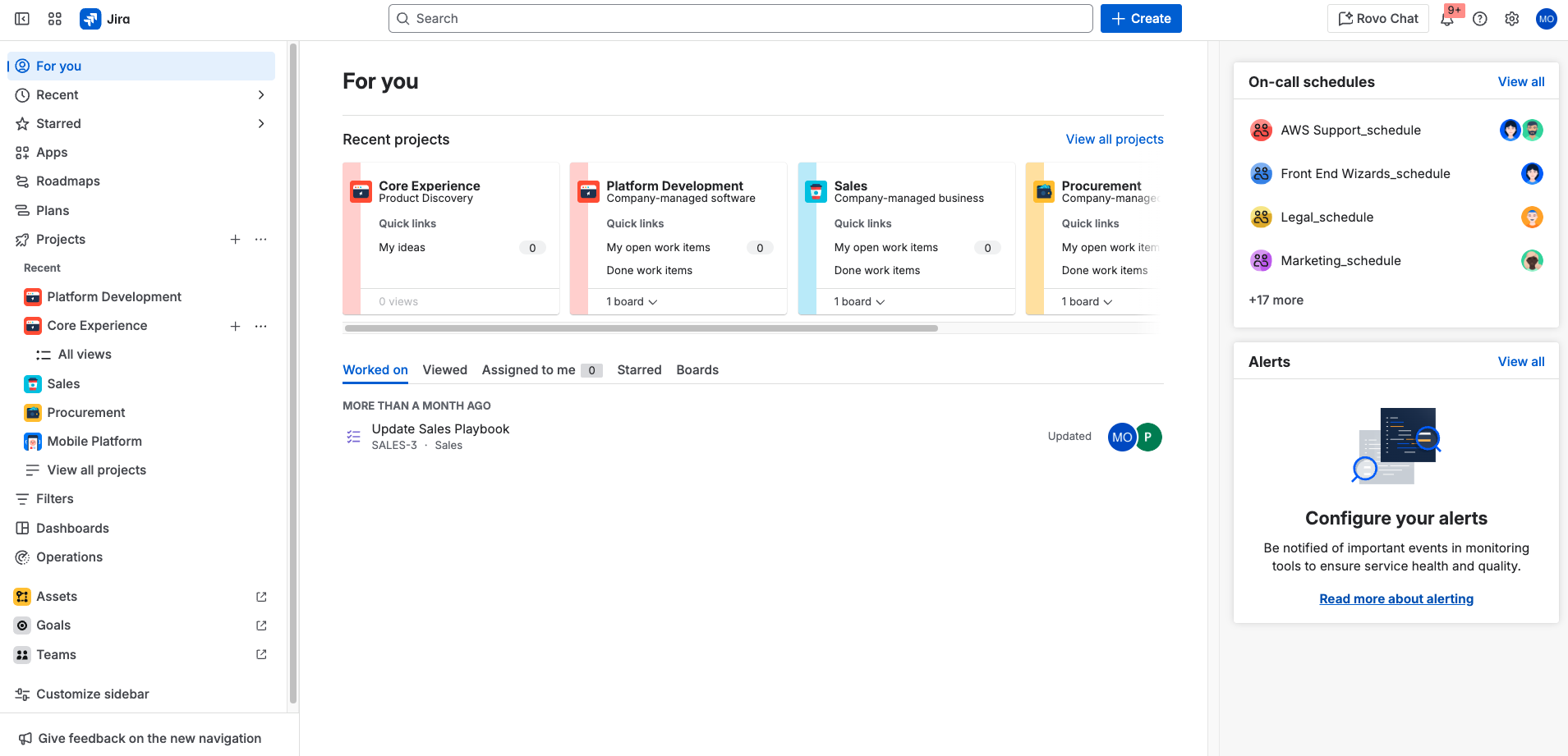
Key changes to board view
The space board and backlog views are very similar in both versions for Scrum/Kanban spaces. In cloud, there’s a 5,000 work item limit per board, and you can view sprint insights to stay on top of progress made and deliver with confidence.
Sprint view
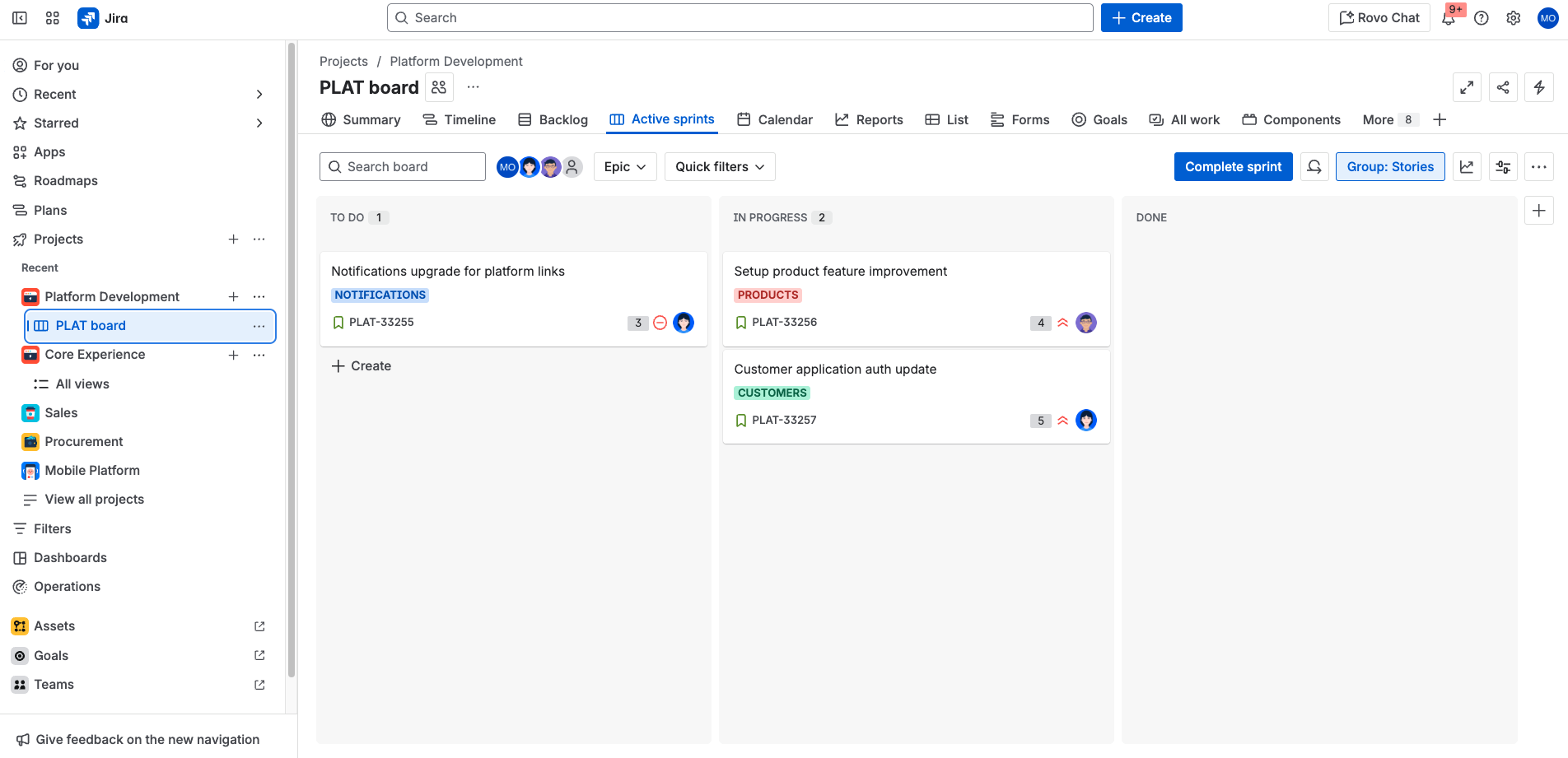
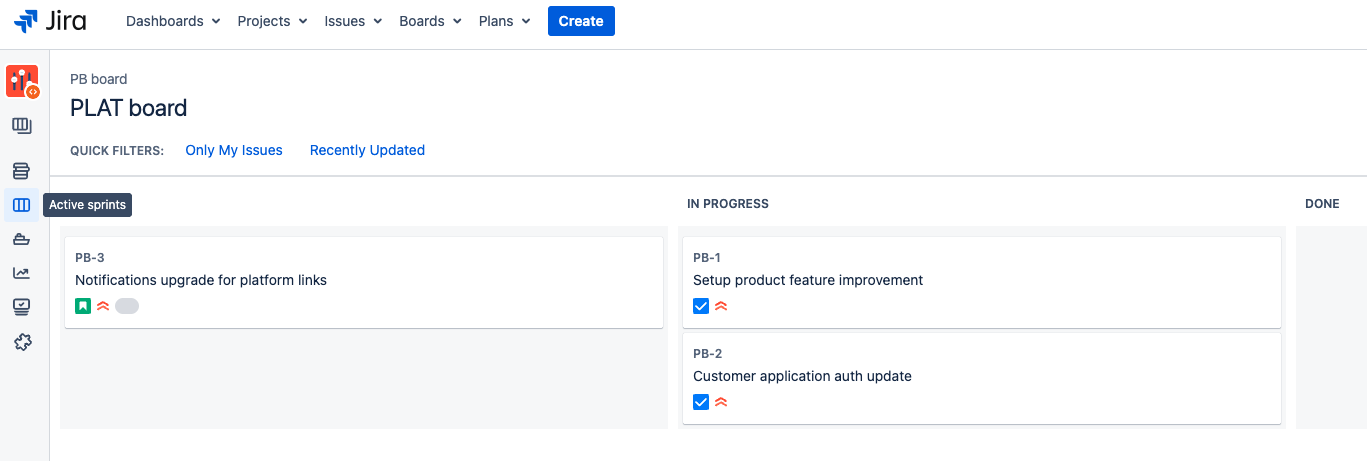
Kanban view
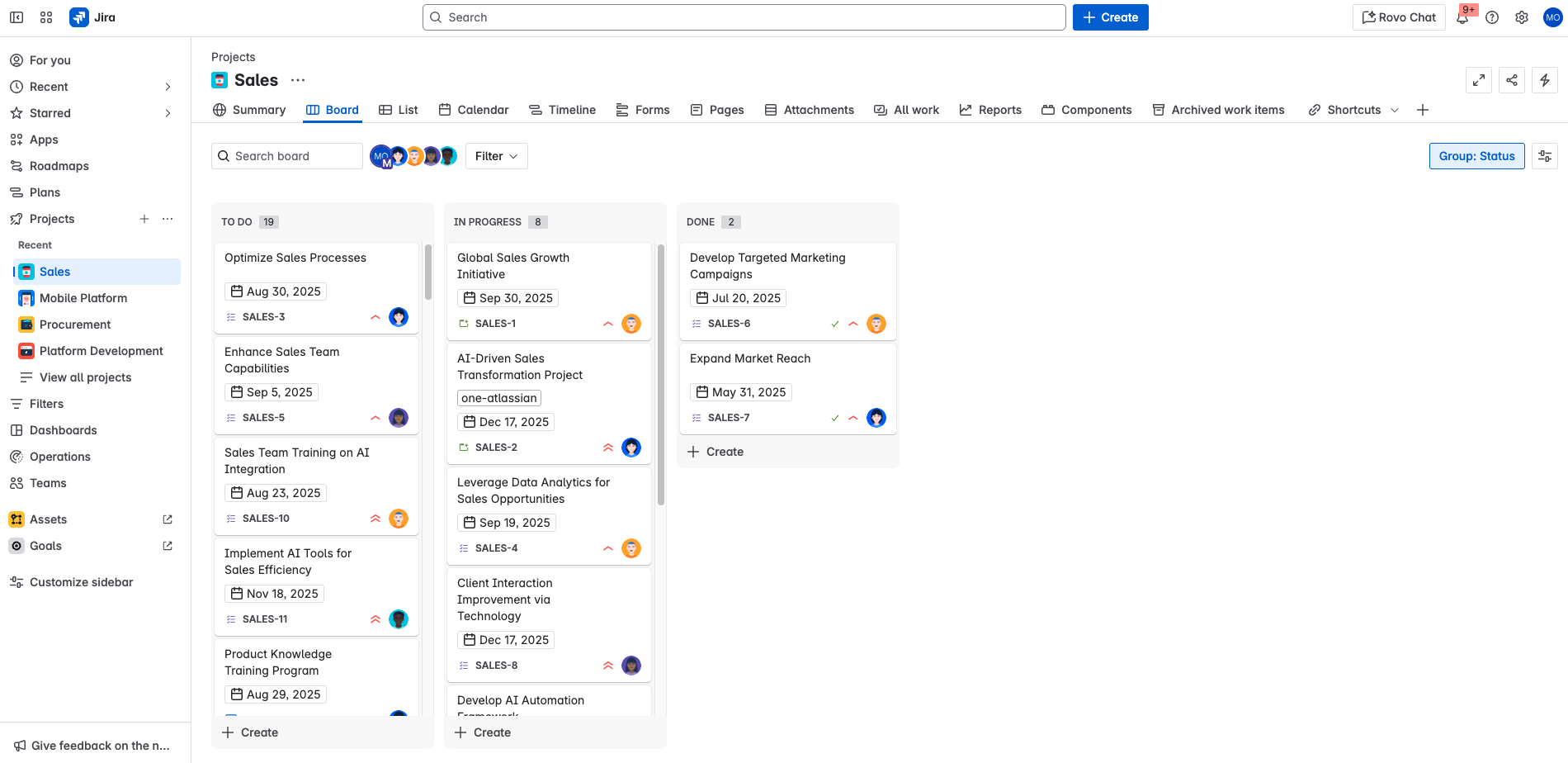
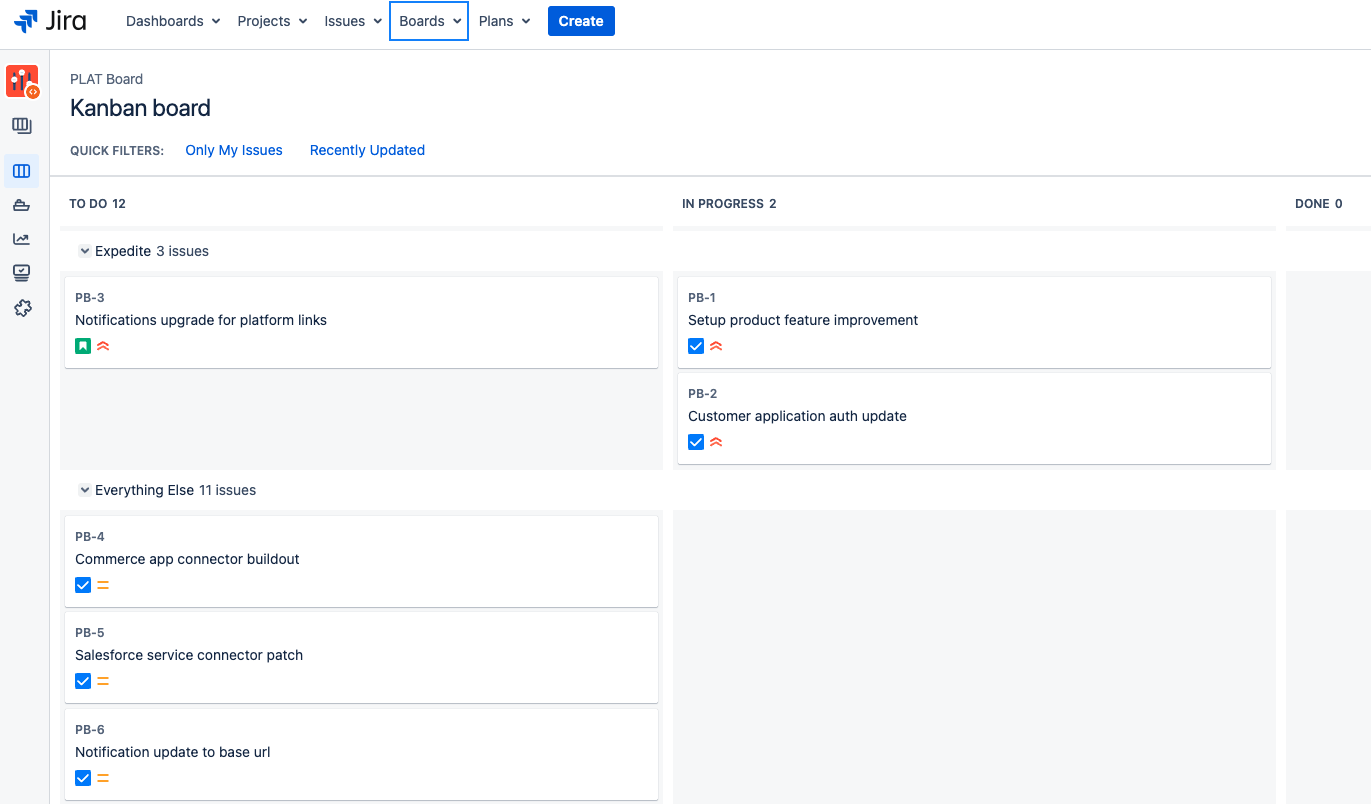
Backlog view
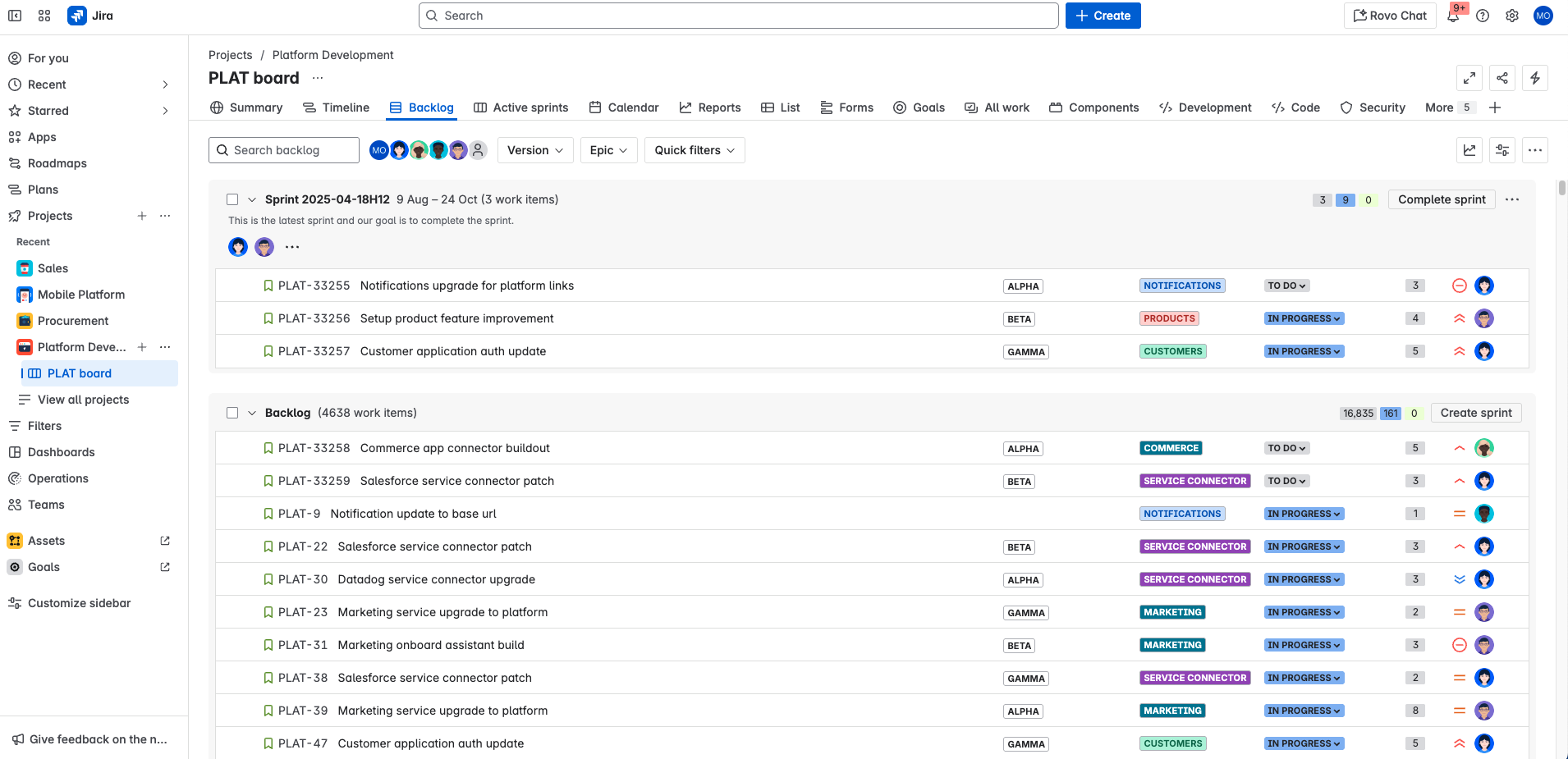
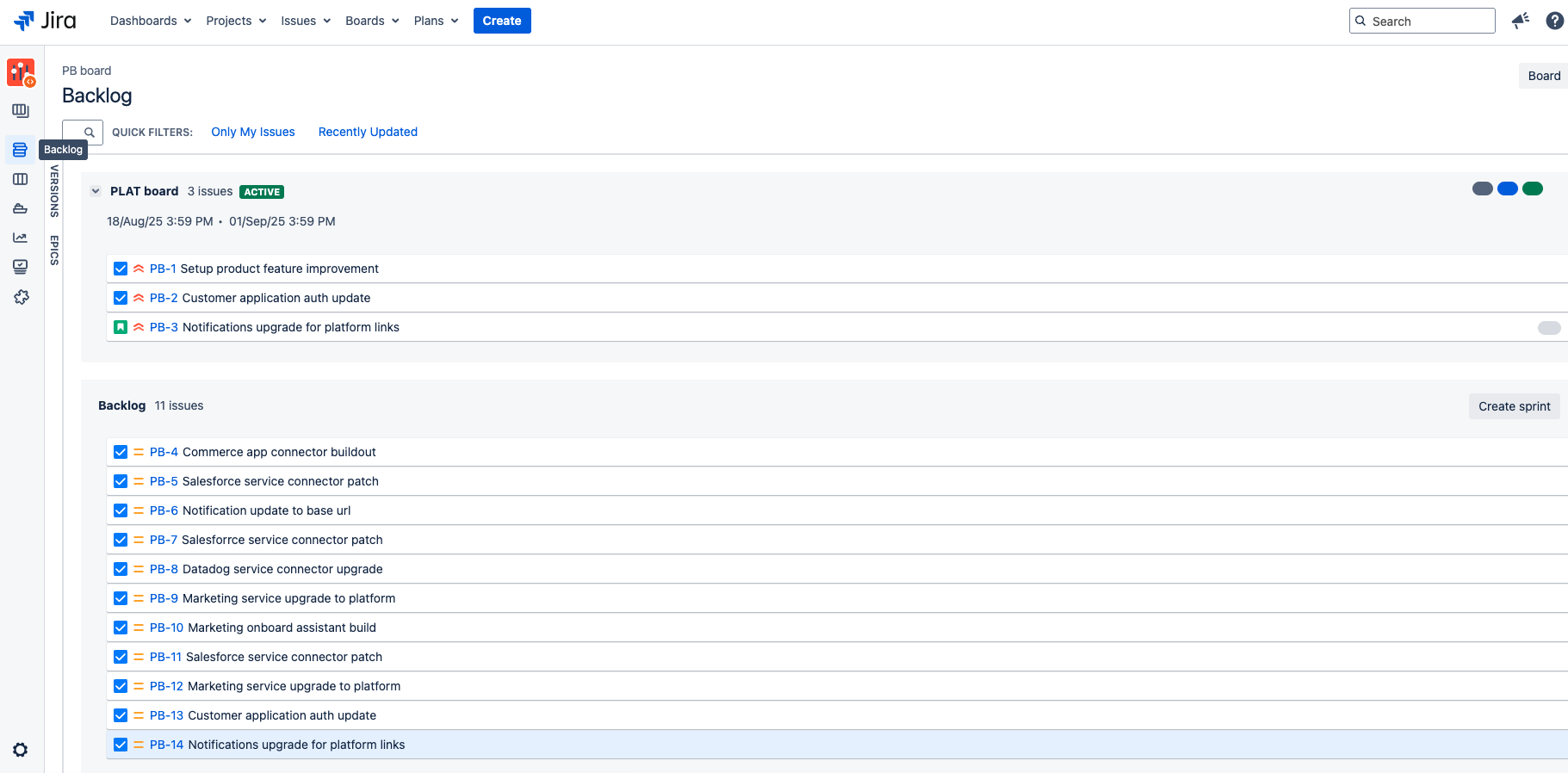
Key changes to work item view
Jira Cloud has a new work item view that groups key actions and information in a more logical way, making it easier for you to scan and update your work items. It usually appears as a 2-column layout on boards and as a single column in the backlog but is responsive to the size of your window.
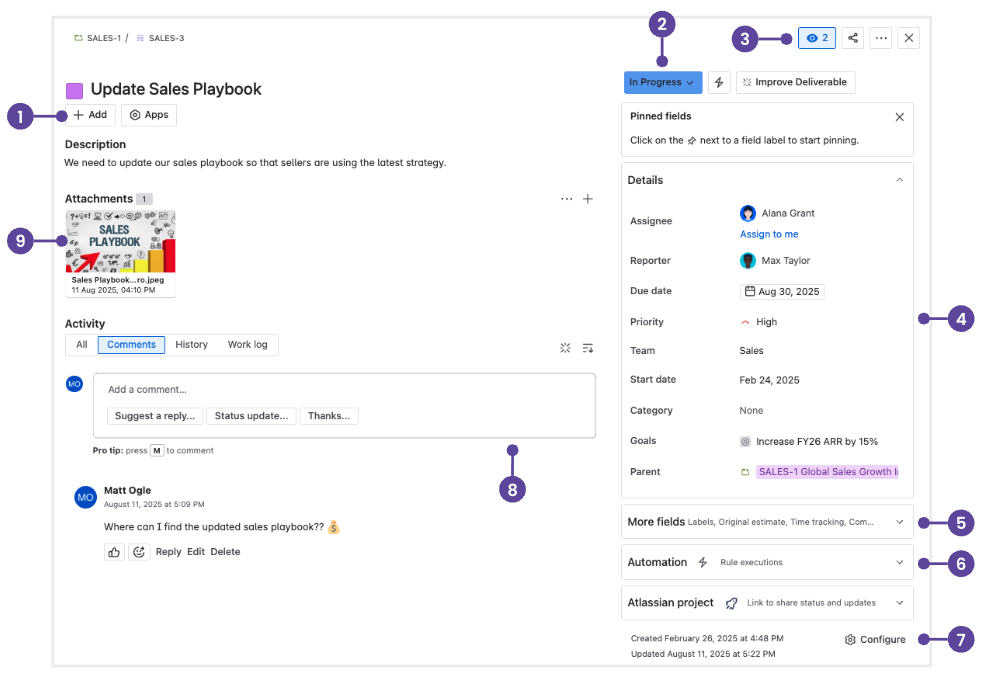
- Quick-add button: Add attachments, subtasks (company-managed spaces), or child work items (team-managed spaces); link to work items, URLs, and content from Atlassian Marketplace apps.
- Transition work item: Update a status, view workflow steps, or take other work item actions by selecting the down arrows (⌄).
- Watch, Vote, and More actions: Watch, vote, and give feedback, and perform other actions like move and clone via the ‘More actions •••’ menu.
- Flexible layout: View and update information organizing your work items including the Development panel linking to development tools like Bitbucket (if connected by your admin). Fields can be placed where they work best for you. On the right side menu, pin your most important and frequently used fields to the top, including the ones under the Show more fields link. To do so, hover over the bold name of the field and select ‘Pin to top’.
- More fields: Select the down arrow (⌄) to view all work item fields.
- Automations: Select the down arrow (⌄) to view Automation rules that have recently run.
- Configure work item layout: Move, hide, and change fields in the work item view for individual spaces.
- Activity and docked Comments bar: Add notes, updates, or questions in the Comments bar. Tag your teammates to notify them or restrict the comment on a public work item.
- Attachments: Switch between the list and strip view for attachments, or download them all at once to work with them on your device.
TIP: Share the Jira Cloud quick start app guide with your users so they can easily reference the changes outlined above.
New ways to manage Jira spaces
While spaces are managed at the company level in data center, you have the option in cloud to manage spaces at either the company or the team level. The core functionality of these space types is the same, but it can be helpful to know which type of space your team is working in if you’re looking for certain configurations.
Team-managed spaces offer a powerful yet simpler configuration that's independent of other spaces on the cloud instance. Anyone on the team can create a team-managed space and serve as the space admin. Space admins administer and have total control over the configuration of their team-managed spaces. This includes configuring workflows, custom fields, work item types, permissions, and more without having to contact the Jira app or site admin. With company-managed spaces, the Jira app admin is responsible for making these types of configuration changes.
TIP: Jira admins can configure and control space settings via Jira Settings > System > Global Permissions.
| | Team-managed space | Company-managed space |
|---|---|---|
Default | Team-managed space Default space type | Company-managed space Can be enabled by admin |
Overview | Team-managed space Simplified configuration that is independent of other spaces. Settings and changes in team-managed spaces can be made by the space admin and are contained; they won’t impact other spaces on the same instance. | Company-managed space Expert configuration with greater complexity and flexibility, but also the ability to standardize workflows across spaces. When a Jira admin changes a scheme or screen, every company-managed space using that configuration changes accordingly. |
Configuration | Team-managed space
| Company-managed space
|
Features | Team-managed space Essential A modern Jira experience for teams who don’t need advanced features.Basic Roadmaps
| Company-managed space Advanced All the power and features that Jira is known for.
|
When to use | Team-managed space
| Company-managed space
|
Popular new features in Jira Cloud
One of the most common reasons customers cite when deciding to move to cloud is to have access to the latest and greatest features in Atlassian apps. We're continuously releasing new value and innovation for you and your teams, and you can see a curated list of some of our most popular new Jira Cloud features in this section.
1. Automation
Jira Cloud’s native automation engine has powerful features which are exclusive to cloud and not available for data center, namely:
- Create variable action
- Lookup work items action
- Sum, min, max, average, and conditional smart values
- The ability to run rules as another user
- Unique triggers
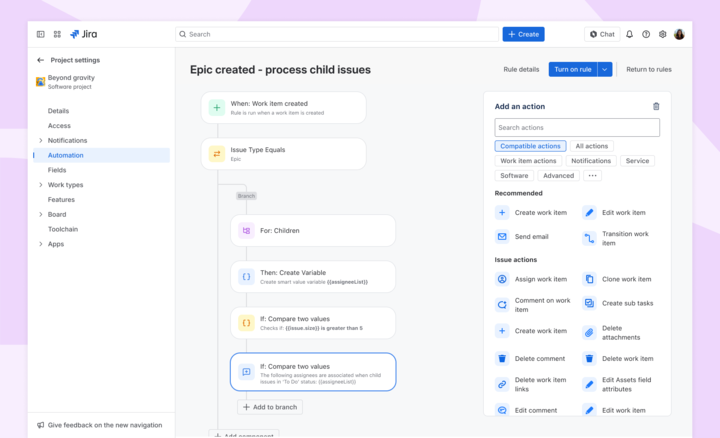
In Jira Cloud, advanced triggers and automation functionality are included out-of-the-box. Learn more about automating your processes and workflows.
2. Plans (included with Cloud Premium and Enterprise plans)
Plans (formerly known as Advanced Roadmaps), which you may have been using as an app with your data center instance, is available out-of-the-box with all cloud Premium and Enterprise plans. Plans are available for company and team-managed spaces.
NOTE: Plans can include work items from all Jira space types.
The cloud version of Plans doesn’t include the ability to create Programs, i.e. group of plans, which is available on data center. However, in most cases, a Program can be duplicated through custom hierarchy levels for Plans. You can learn more about how to get started with advanced planning here.
3. Basic roadmaps
For all cloud plans, you can use the space-specific roadmap. The roadmap is where you can create, manage, and visualize your team's epics. Roadmaps are useful for planning large pieces of work several months in advance and planning large groups of stories across different sprints. While Plans provide the ability for cross-space roadmaps, basic roadmaps are for single spaces.
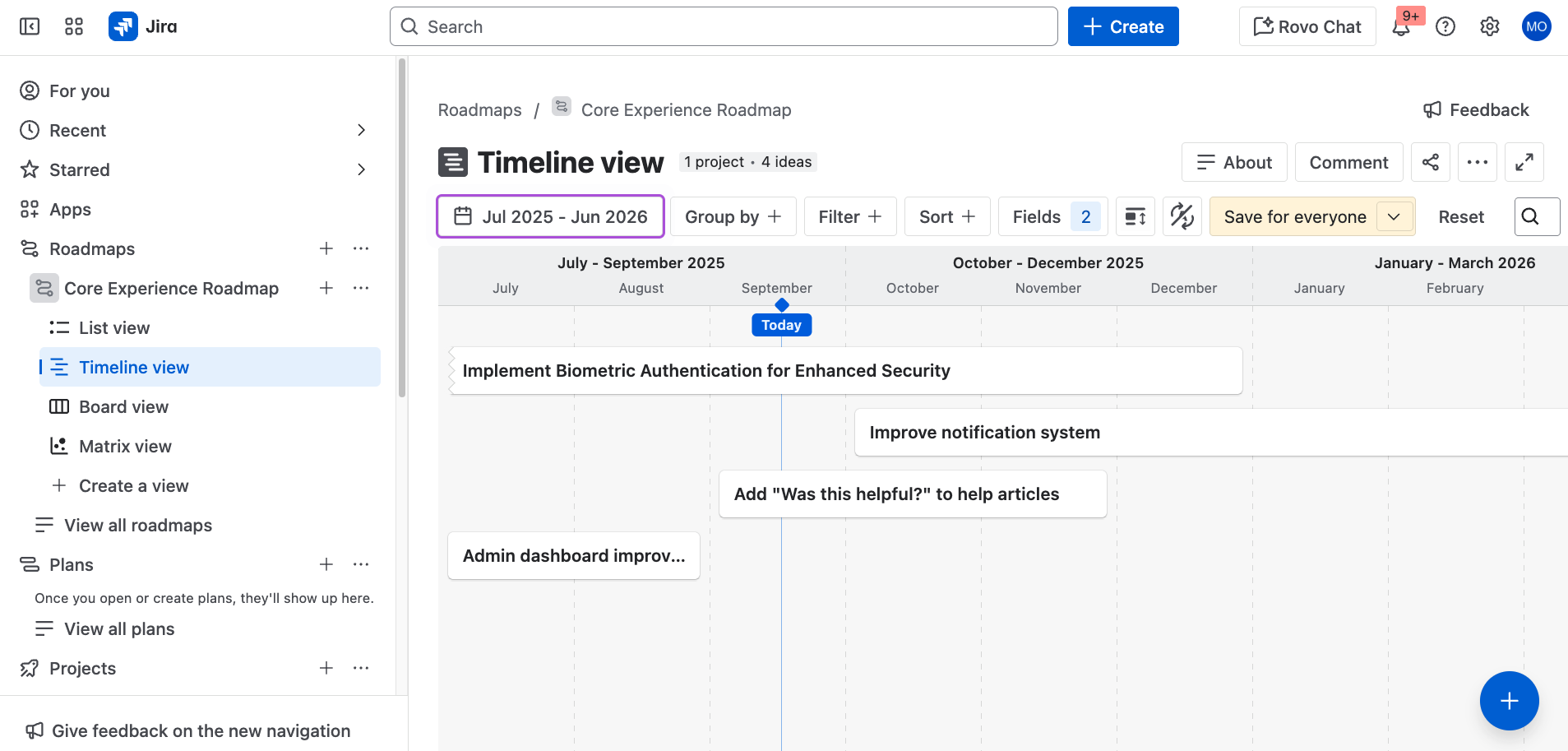
4. Space templates
Jira Cloud offers over 40 ready-to-use space templates for many use cases, with more being shipped on a regular basis. Jira Enterprise plan also offers custom space templates that allow admins to reduce space setup time by reusing settings from existing spaces.
5. DevOps Insights
If your admin has integrated your CI/CD pipeline with Jira, you can take advantage of DevOps Insight, which includes cycle time and deployment frequency reports and insights that can be used to analyze risk and measure how often you are shipping value to your customers.
6. Better integrations
With Jira Cloud, integrating with other Atlassian apps like Confluence, and third party tools like MS Teams and your development tools is easier than ever.
7. AI capabilities
Built-in AI helps you work smarter, faster, and more collaboratively. Instead of spending time on completing manual tasks and updates, Jira AI handles the details so you can focus on impact. Here are a few ways you can start using Jira AI capabilities:
- Work breakdown: Turn high-level ideas into manageable tasks with AI-generated summaries, descriptions, and subtasks.
- Workflow guidance: Use Rovo Agents like the Workflow Builder or Work Readiness Checker to design processes, check task clarity, and ensure spaces stay on track.
- On-demand context: Surface related Jira work items, Confluence pages, and even in-line definitions directly in your workspace, so you always have the right information at hand.
You can learn more about how to use AI in Jira with these resources:
Key differences in Jira Service Management Cloud
New space types
In addition to the standard IT service management and customer service management templates, Jira Service Management Cloud also has space templates for other teams such as HR, Marketing, Finance, Sales and Legal that are not available in Jira Service Management Data Center.
Find your templates
Start your space off right with a pre-configured template. Or showcase how your team works. Submit your template idea here.
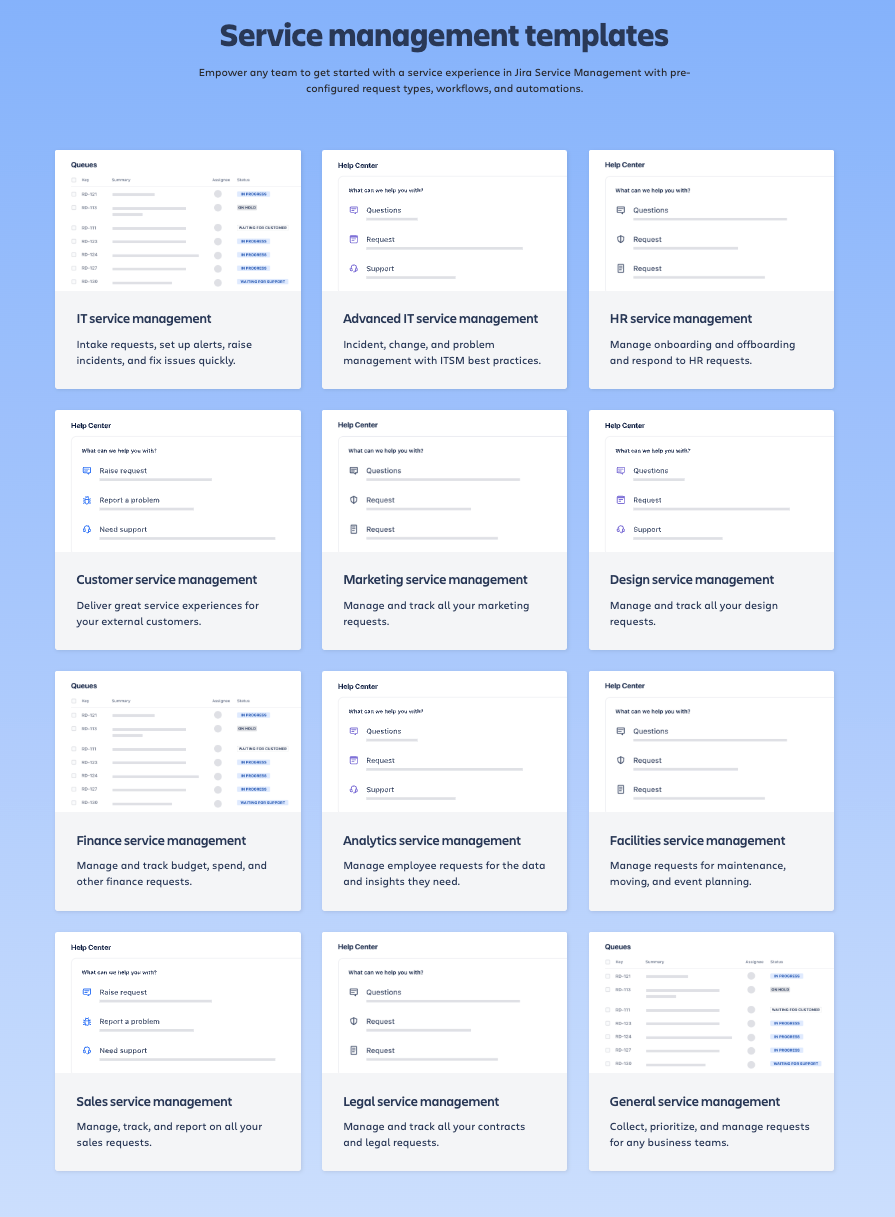
Changes to the work item view
The new Jira work item view experience outlined in the Jira section above is now available across all Jira apps, including Jira Service Management. This means a better and more consistent experience for users. Take a look at the screenshot below to see how it all comes together:
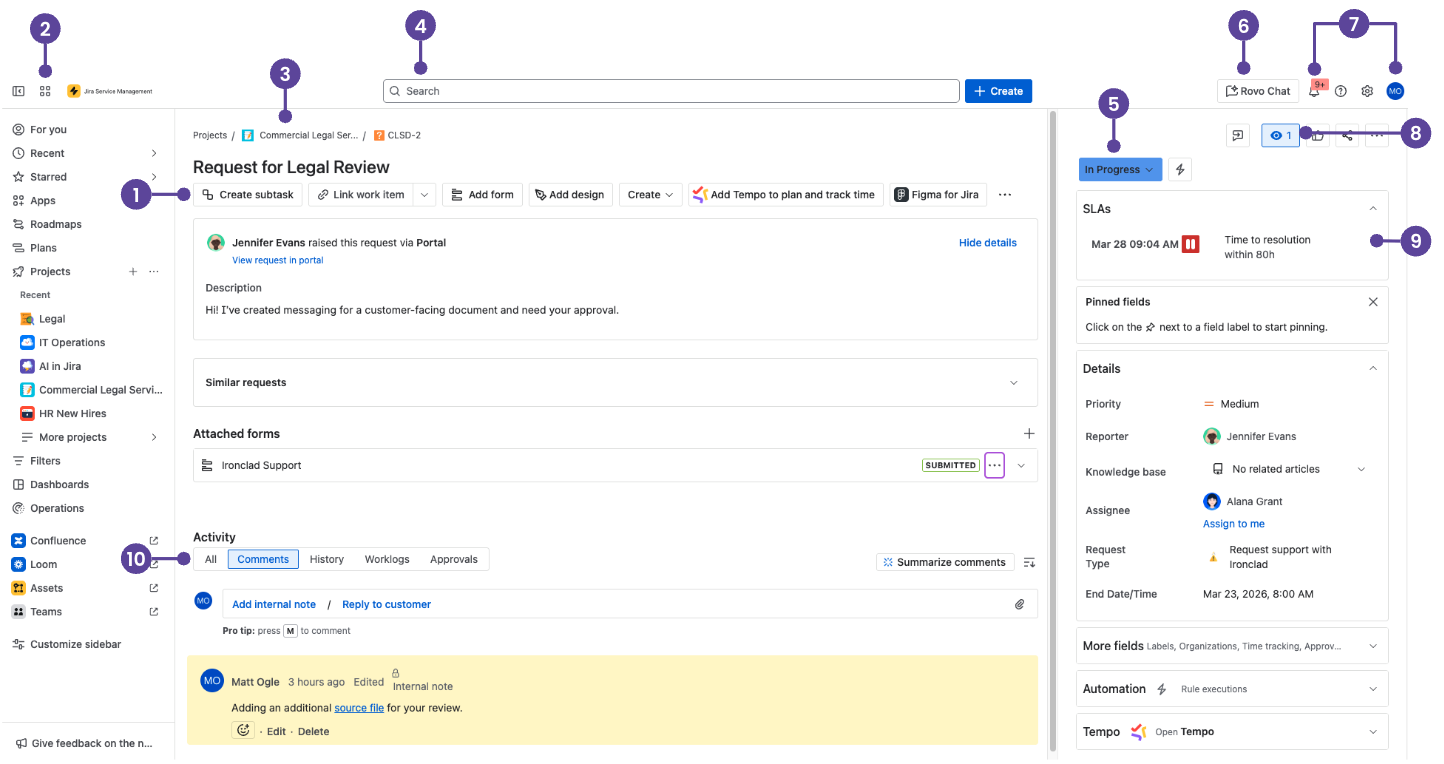
- Quick-add buttons: Create subtasks or link work items, add web or Confluence links, or add content from Atlassian Marketplace apps.
- App switcher: Switch between Atlassian and third-party apps, like Confluence, Talent, and Miro, or go to other sites.
- Back to queues: Go back to your queues with a single click.
- Search: Find work items, spaces, boards, queues, filters and people. If enabled, paid editions get AI-powered, cross-app search via Rovo.
- Work item status: Select the status, then choose a transition to change the work item status.
- Rovo Chat: Ask questions and explore your company’s knowledge through an AI-powered chat interface. Rovo chat is available on paid editions and must be enabled by admins.
- Notifications, Help, Settings, and your profile: See what's happening in Jira Service Management, get help, and customize settings (Jira Service Management admins only) and your personal settings.
- Watch, Share, and Actions: Watch the work item or perform other actions like move and clone via the Actions menu.
- Context fields: These can include SLAs, request participants, and other information to help describe the work item. Under context fields, select ‘Show more fields’ (or ‘More fields’ in team-managed spaces) to reveal empty fields that aren't always shown on the work item view.
- Comment bar: To add a comment, select ‘Add internal note’ to post a comment that only your team can see (highlighted in yellow), or ‘Reply to customer’ to include the person that raised the request. Select the ‘Attachments’ paperclip icon to add an attachment.
TIP: Share the Jira Service Management quick start product guide with your users so they have easy access to the shortcuts above.
Assets in cloud
Assets are Jira Service Management’s native asset and configuration management tool (included in Jira Service Management Cloud Premium and Enterprise). Stored assets and CIs are referred to as objects, grouped by object type, and organized within schemas to visualize critical relationships. It is compatible only with company-managed spaces.
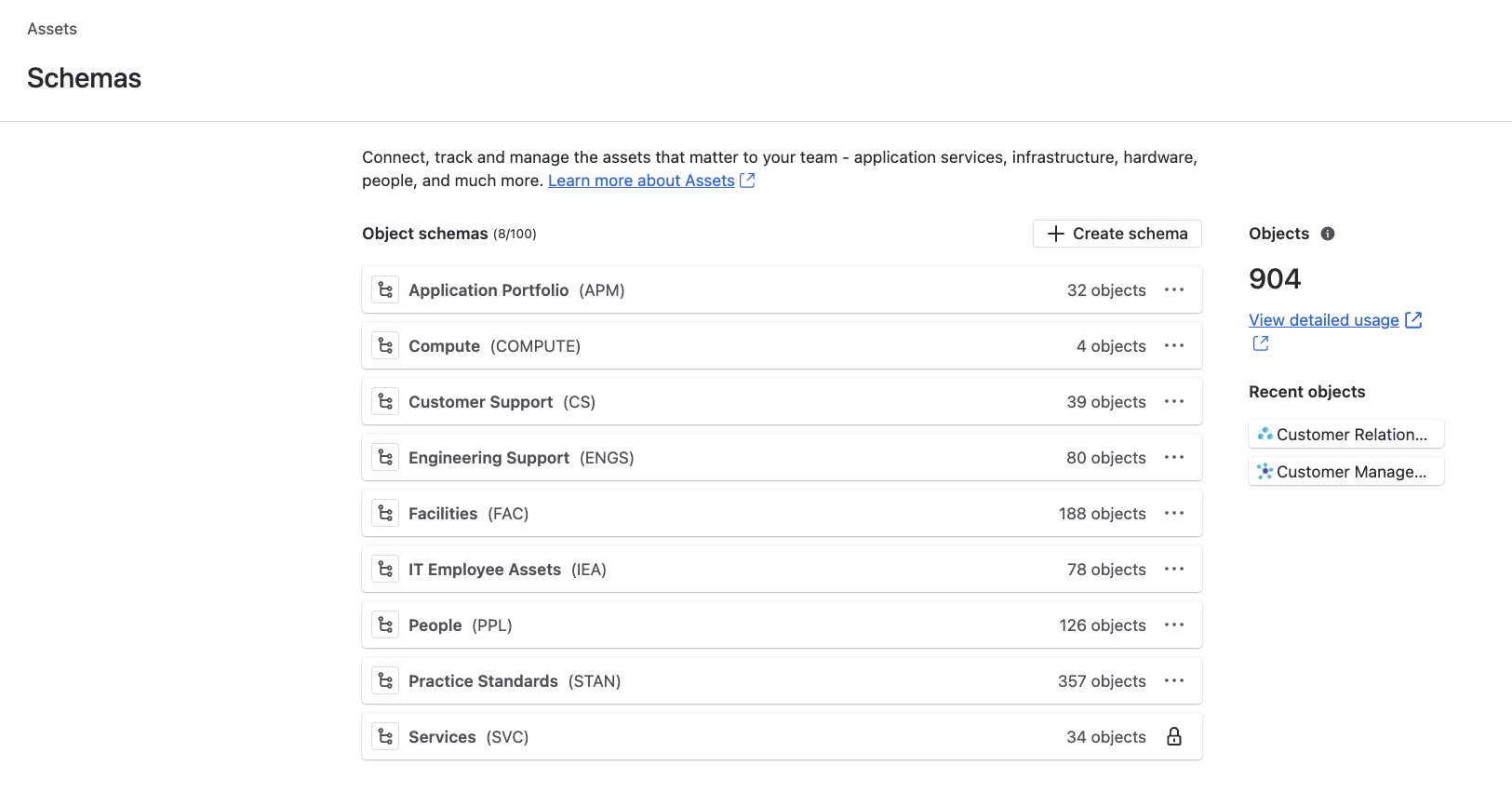
Queues and the new agent experience
With the new agent experience, service teams are now able to triage work items more effectively, scan request details at a glance, and deliver speedy responses to customers.
Queues can be better customized to your teams' needs
Replying to your customers is easy
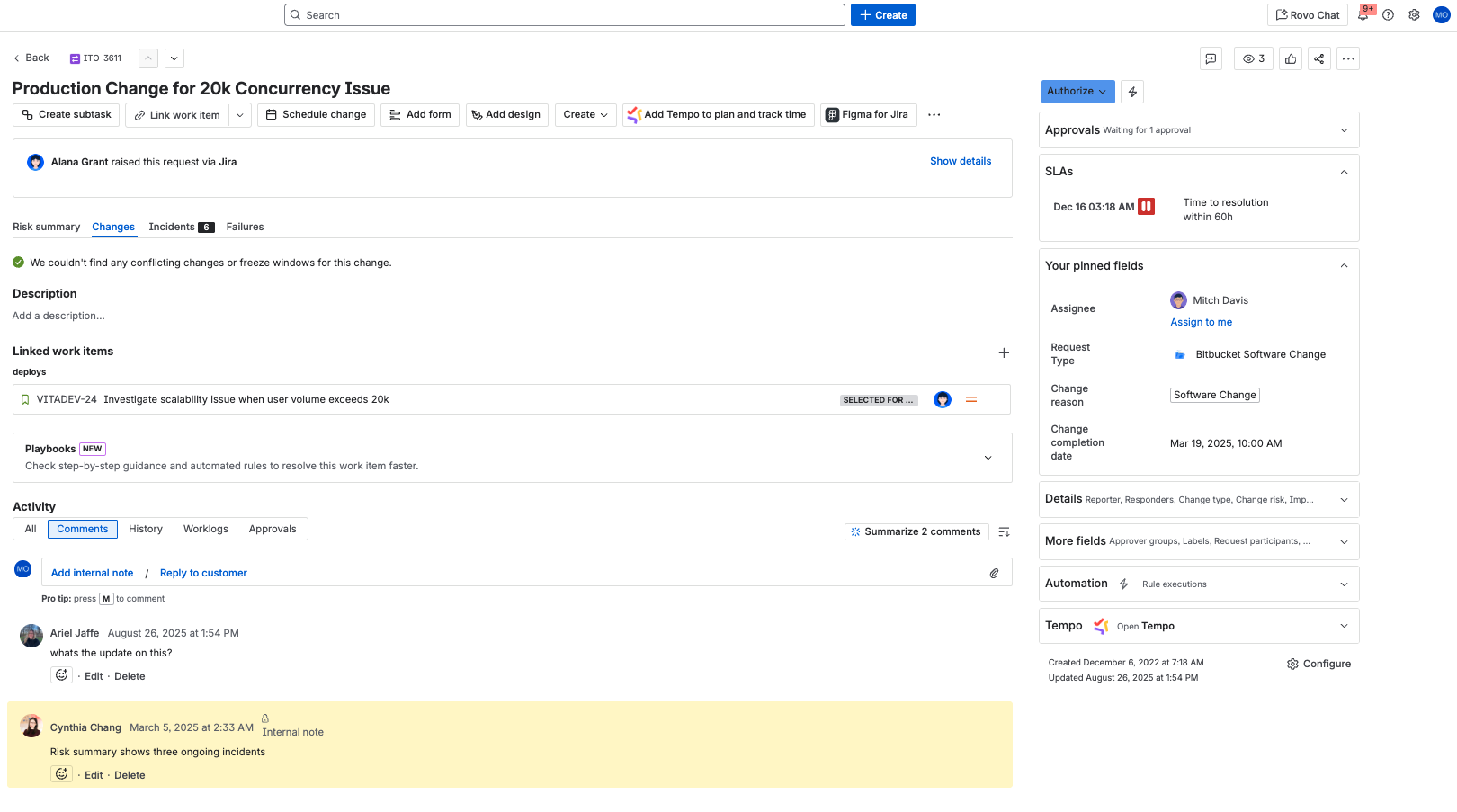
Triaging is faster with queue actions
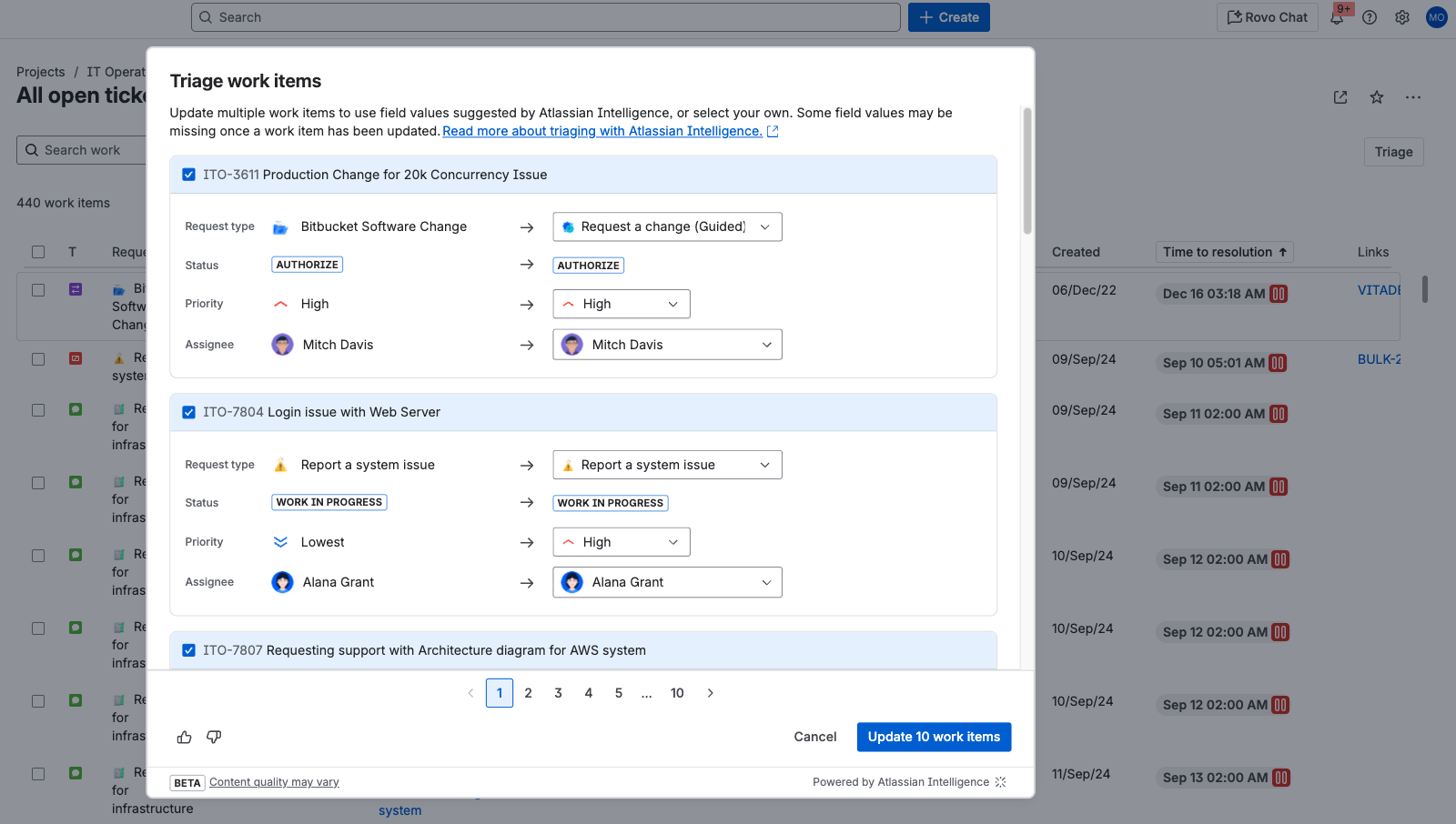
Agents can quickly navigate to favorites
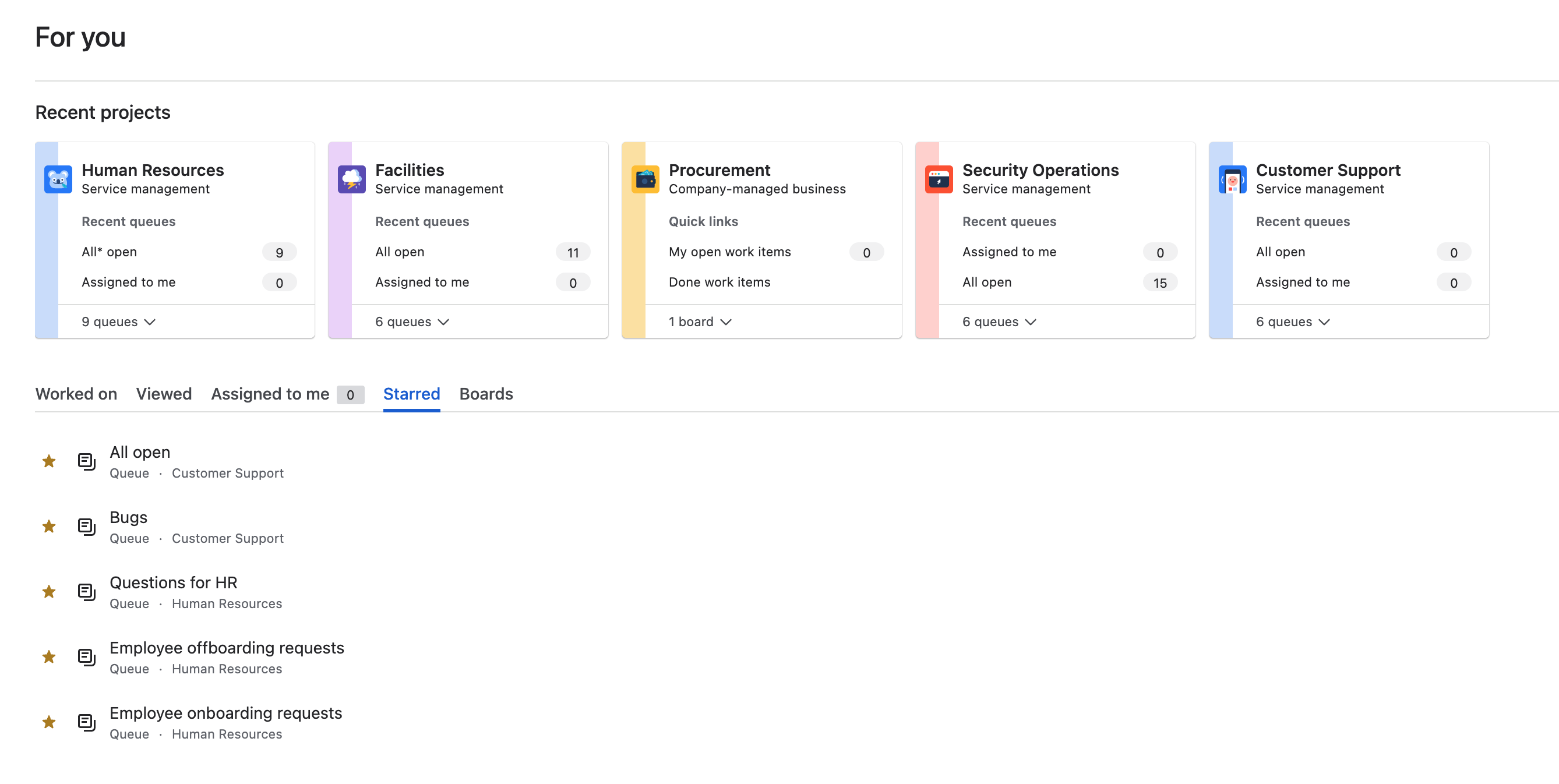
NOTE: Read this Community post to learn more details on each improvement outlined above.
Differences in the Help Center and Portal
Cloud offers more branding and customization capabilities, including the ability to:
- edit the login screen message and Help Center layout
- customize the columns in your customers' Request lists (to quickly filter and find the requests they’re looking for a status update on)
-
implement dynamic forms, checklists, and specific validation rules using forms for Jira
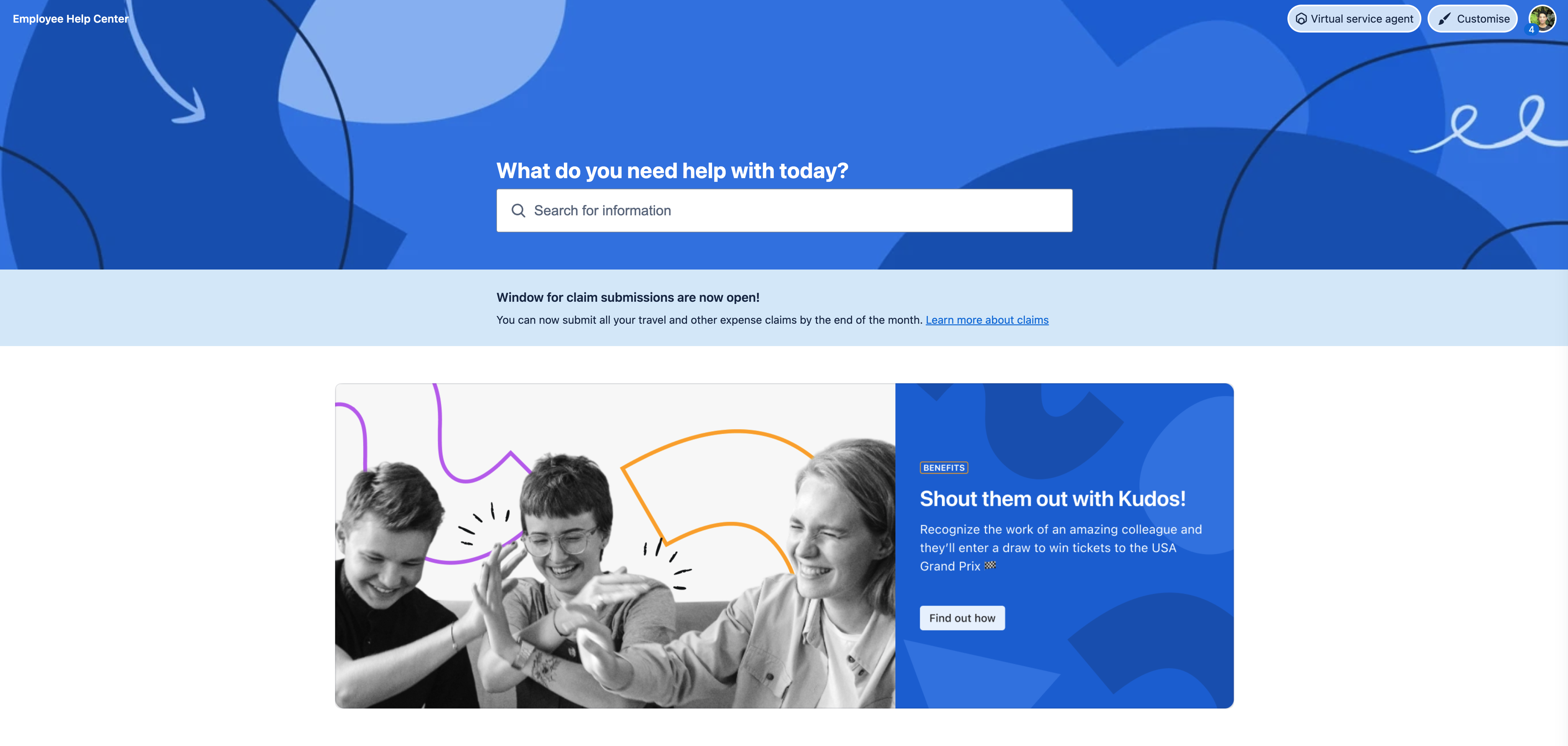
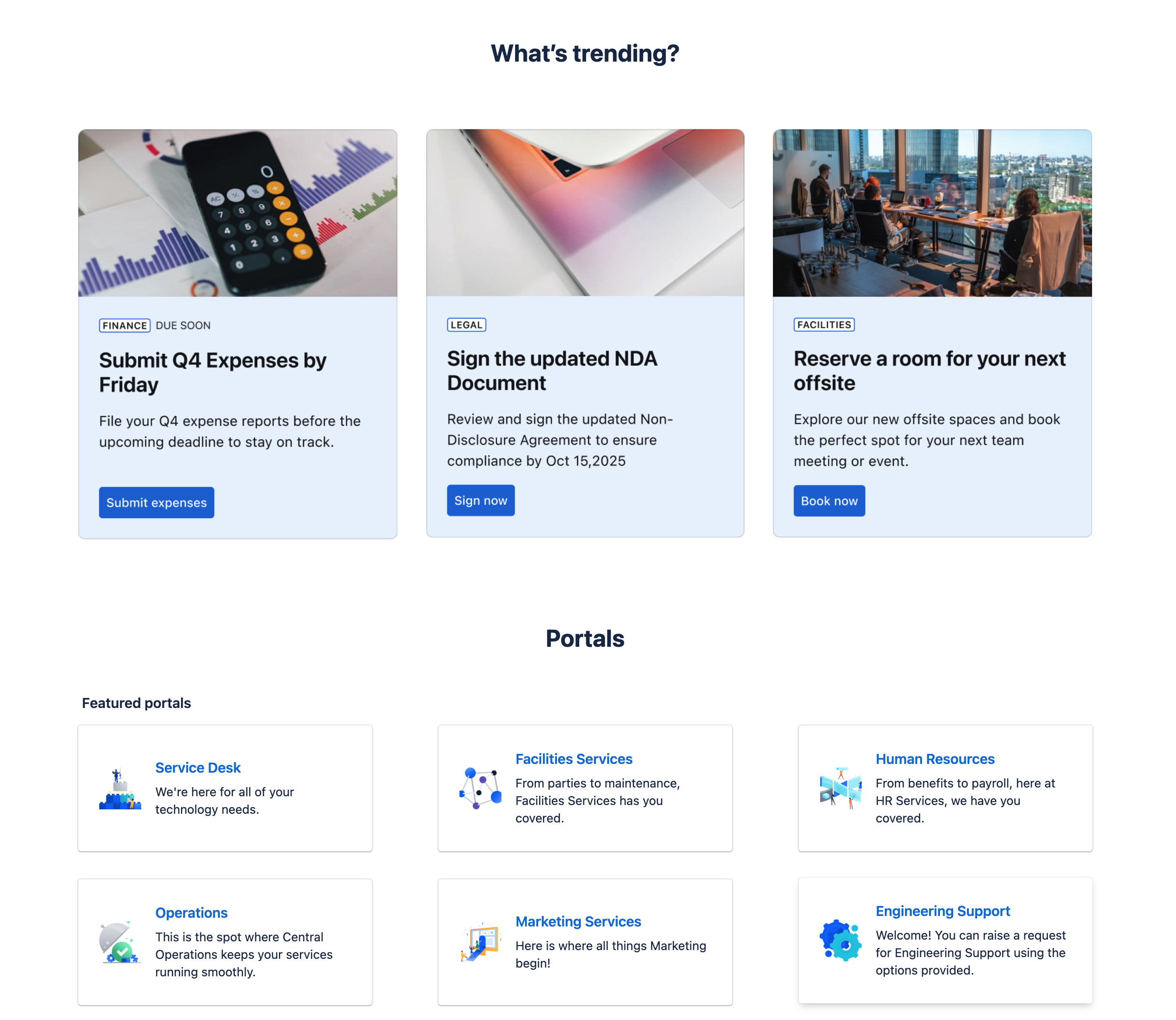
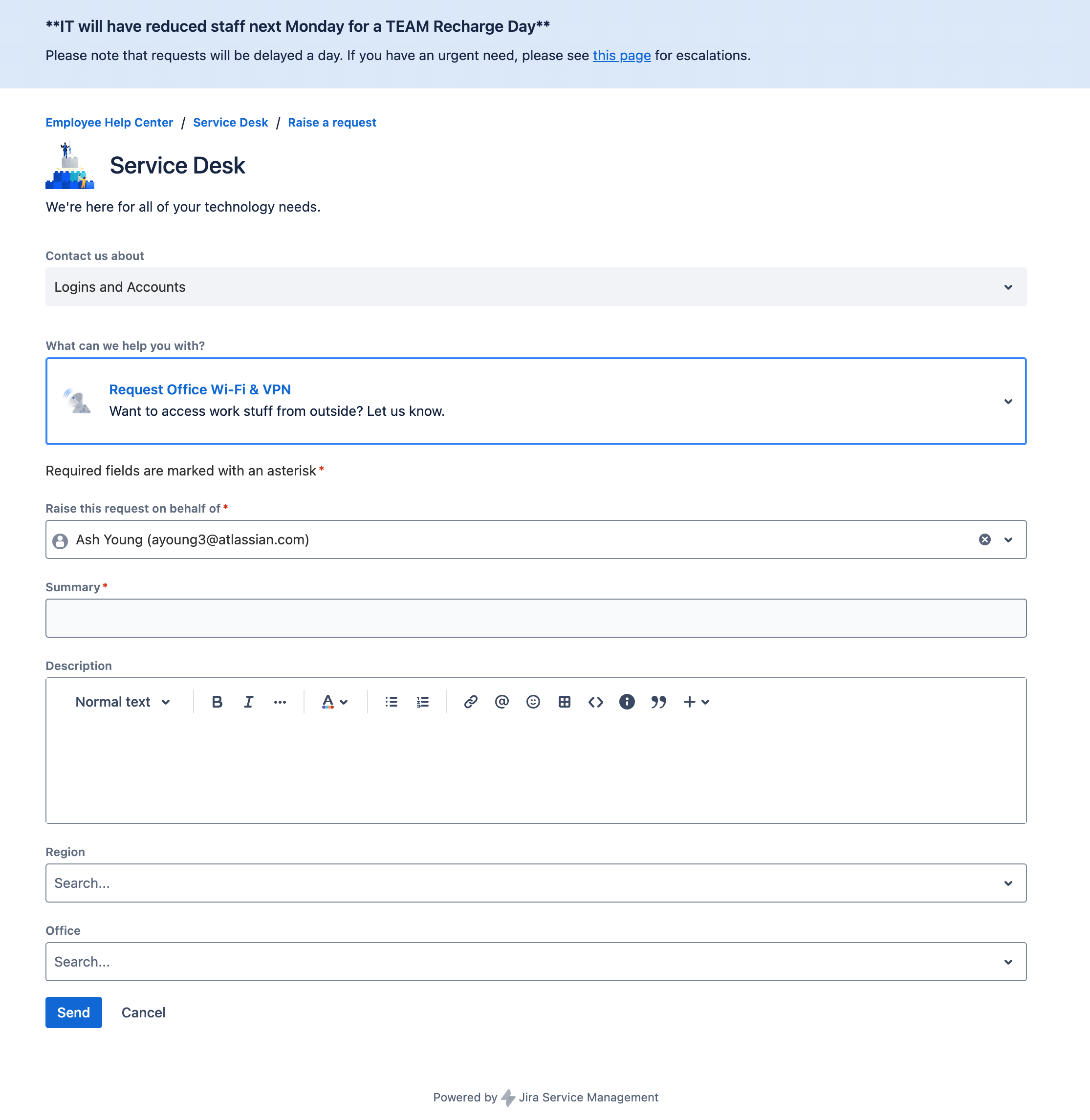
Help channels
Just like in data center, requests in cloud can be created via the Help Center, email, and APIs.
In Jira Service Management Cloud, you can embed the portal widget on any page of your site/app to collect requests from your customers. See how the widget works in practice.
NOTE: Atlassian Cloud apps come with an internal SMTP server configured to send notifications. The internal SMTP server is not configurable, but you can configure Jira Service Management Cloud to send emails on behalf of your domain. For more information on how to use a custom 'space Email Address' with your domain, refer to Configuring Jira Cloud to send emails on behalf of your domain.
Incident management functionality
Opsgenie features such as alerts, on-call schedules, incident command center, post mortems, and heartbeats are bundled in Jira Service Management Cloud.
Change management features
Change management in cloud has additional features which can help teams better plan, schedule, and deploy changes to production. Change calendars and change management automation with connected CI/CD tools ensure that nothing falls through the cracks.
AI capabilities
Jira Service Management includes powerful AI features that help teams deliver exceptional service experiences more efficiently and with less manual effort. Here are some of the ways AI can accelerate your service management outcomes:
- Always-on, self-service support: Instantly resolve common requests by automating tier 1 support interactions and providing users with accurate answers from your knowledge base, reducing repetitive tickets and freeing up agent time.
- Accelerated triage and response: Boost service team productivity with AI-powered suggestions and actions. Automatically prioritize your queue, summarize work items, identify the best assignees, recommend troubleshooting steps, and draft responses for quick resolution.
- Intelligent incident management: Streamline incident detection and response with AIOps capabilities that prioritize critical alerts, surface related incidents and changes, suggest root causes, and route work items to the right team members for faster, more effective resolution.
Key differences in Confluence Cloud
Home page
Both cloud and data center have a common access point to the home page: the ‘Confluence’ logo at the top left. Most elements of the cloud home page are also on the data center home page and relatively straightforward to find. However, the home page itself has a very different appearance and layout as you can see below.
Navigation
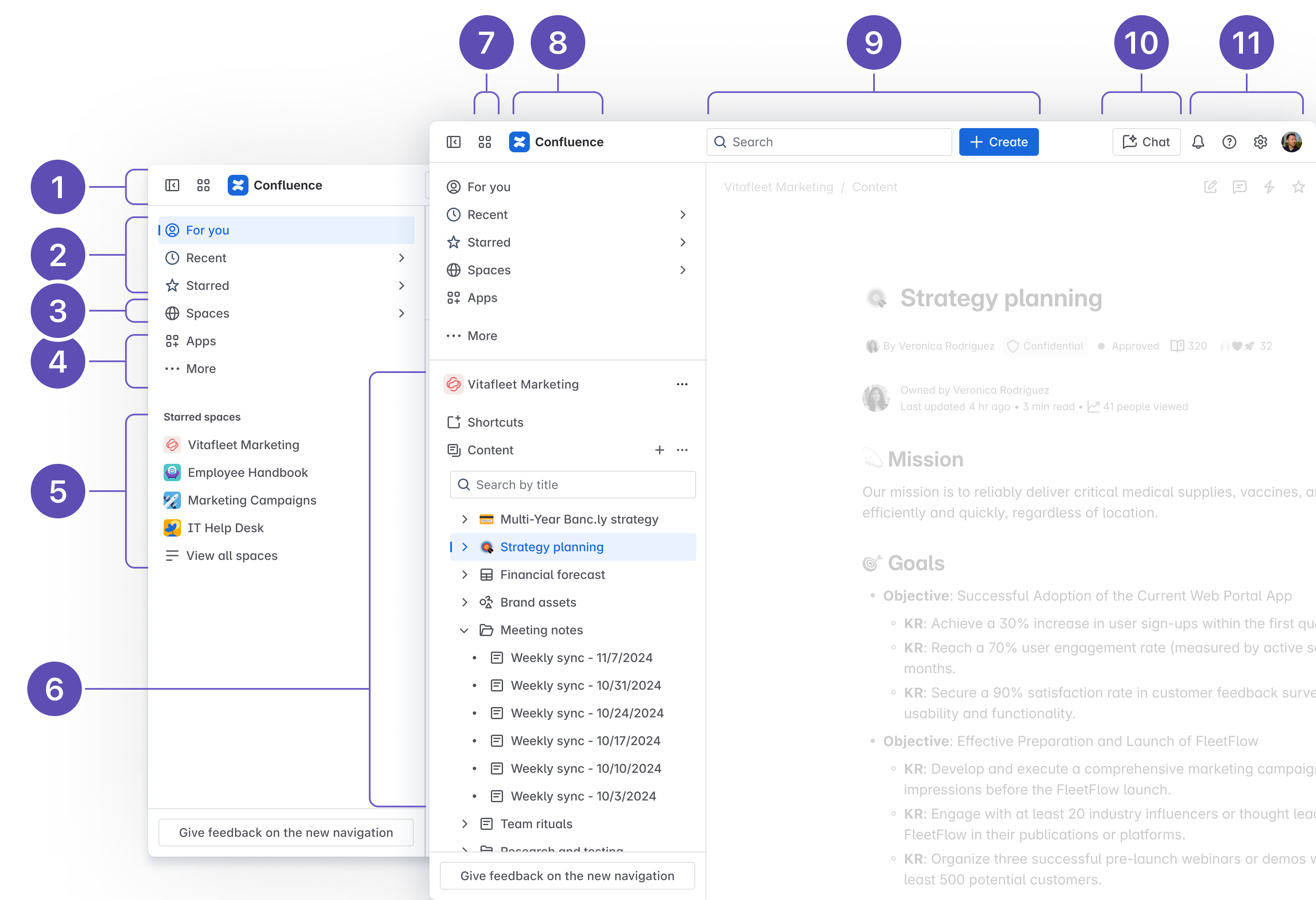
Navigation in cloud is redesigned to help you find what you need faster. The top navigation is decluttered to streamline essential actions like search and create. Everything else lives in a customizable sidebar, giving you more control over how you move through Confluence. Read the blog to learn more.
-
Collapsible sidebar: Hide the sidebar for a distraction-free, wider view of your content.
- Access the essentials. 'For you' allows you to discover trending content from across your site and updates from people you follow. 'Recent' & 'Starred' allows you to quickly jump back into content you've recently viewed, edited, or starred.
- Spaces: Browse all your spaces. Starred spaces are pinned to the top and recently visited ones just below
-
Apps & More: See and manage apps installed on your Confluence site. Note: Calendars and Analytics (Premium and Enterprise only) in your previous navigation bar are now located in this menu. Find apps like Teams (formerly People) under More—and pin them for easy access.
-
Starred spaces: When you’re not inside a space, starred spaces appear here for quick access.
-
Space content: When you’re inside a space, this section shows the space’s content tree in place of starred spaces.
-
App switcher: Switch between Atlassian sites or apps, or collapse the sidebar for a distraction-free, wider view of your content.
- Confluence logo: Click the Confluence logo to return to ‘For you’ from anywhere.
- Search & Create: 'Search' allows you to find content, spaces, and people across Confluence. If enabled, paid editions get AI-powered, cross-app search via Rovo. 'Create' allows you to start any content type—live docs, pages, whiteboards, blogs, databases, smart links, or entire spaces—from one central spot.
- Rovo Chat: Ask questions and explore your company’s knowledge through an AI-powered chat interface. Rovo chat is available on paid editions and must be enabled by admins.
- Notifications, Help, Settings, and your profile: Stay updated, get support, and personalize your experience.
General interface
Both versions include a sidebar for navigating space content, but some elements have moved. One key change: Space settings is now located under More actions (•••) next to your space’s name in the sidebar.
Editor
This is one of the biggest differences you’ll notice in cloud, as we’ve made significant updates to the cloud editor:
- Floating action toolbar: Frequently used tools—like comments and page details—now live in a dedicated floating toolbar on the right, so they’re easier to find and no longer buried in the editing toolbar.
- Pinnable editing toolbar: Choose how you work – let the toolbar follow you inline for faster editing, or pin it to the top for a more fixed experience.
- Templates: Get started faster with a bigger library of templates.
- Macros: In cloud, we’ve removed older macros (especially those that hurt performance) and replaced them with simpler, built-in commands. You can see a list of the removed macros and alternative methods here. Cloud does not currently support user macros.
Autocomplete keyboard shortcuts in editor
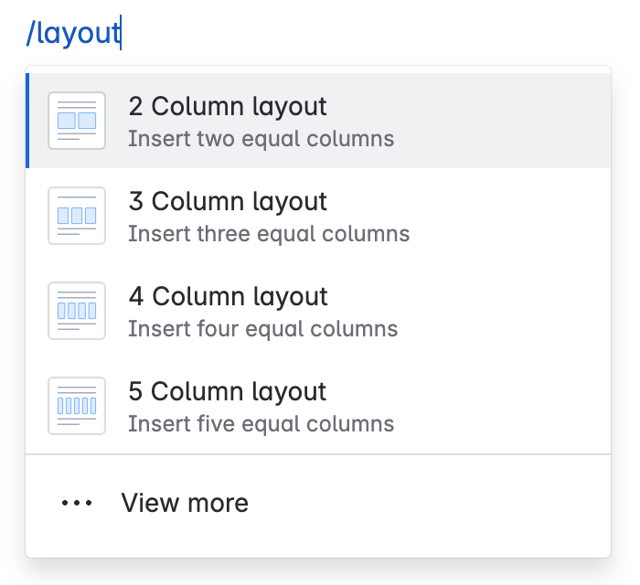
One of the biggest changes that power users will pick up on are the autocomplete shortcuts used in the editor. Those accustomed to the data center editor may be very familiar with the { wiki markup notation to insert macros. In cloud, you’ll switch to using the / slash command—a single, streamlined way to access macros, elements, and tools as you type.
Action | Cloud autocomplete character | Server/Data Center autocomplete character |
|---|---|---|
| Tables | Cloud autocomplete character / | Server/Data Center autocomplete character | |
| Links | Cloud autocomplete character / | Server/Data Center autocomplete character [ |
| Images | Cloud autocomplete character / | Server/Data Center autocomplete character ! |
| Macros | Cloud autocomplete character / | Server/Data Center autocomplete character { |
| Headings | Cloud autocomplete character # | Server/Data Center autocomplete character h1. |
| Lists (unordered) | Cloud autocomplete character * | Server/Data Center autocomplete character * |
| Lists (ordered) | Cloud autocomplete character 1. | Server/Data Center autocomplete character # |
TIP: Share the Confluence quick start product guide with your users so they have easy access to the shortcuts above.
Other editor changes
- Inline comment: In cloud, adding inline comments works the same whether you're editing or viewing a page:
- Highlight the text you want to comment on.
- Click the 'Add comment' button that appears.
- Type your comment and hit 'Save' (Ctrl+S or ⌘+S).
- Anchor links: Anchor links are automatically created in cloud for headings. Non-heading links still need to be specified by the Anchor macro.
- Adding attachments: To add attachments in cloud, copy and paste the file’s link directly to the page. Note: Users familiar with embedding or linking attachments from shared file libraries may need to adjust their workflows.
- Editing tables: Table editing in cloud has been redesigned for a more intuitive experience. While this is designed to be easier in the long run, it may feel different at first—consider giving your team a heads-up.
Smart Links
Smart Links reveal important context about links within a Confluence page (or Jira work item) without leaving that page. When you paste a supported link into the editor, it automatically converts into a Smart Link, giving you a quick preview of key details.
Smart Links work with Atlassian tools (like Confluence, Jira, Loom, Trello, and Bitbucket) and many third-party apps (like Google Drive, Figma, and Slack).
You can choose how each Smart Link appears—there are a few different display options:

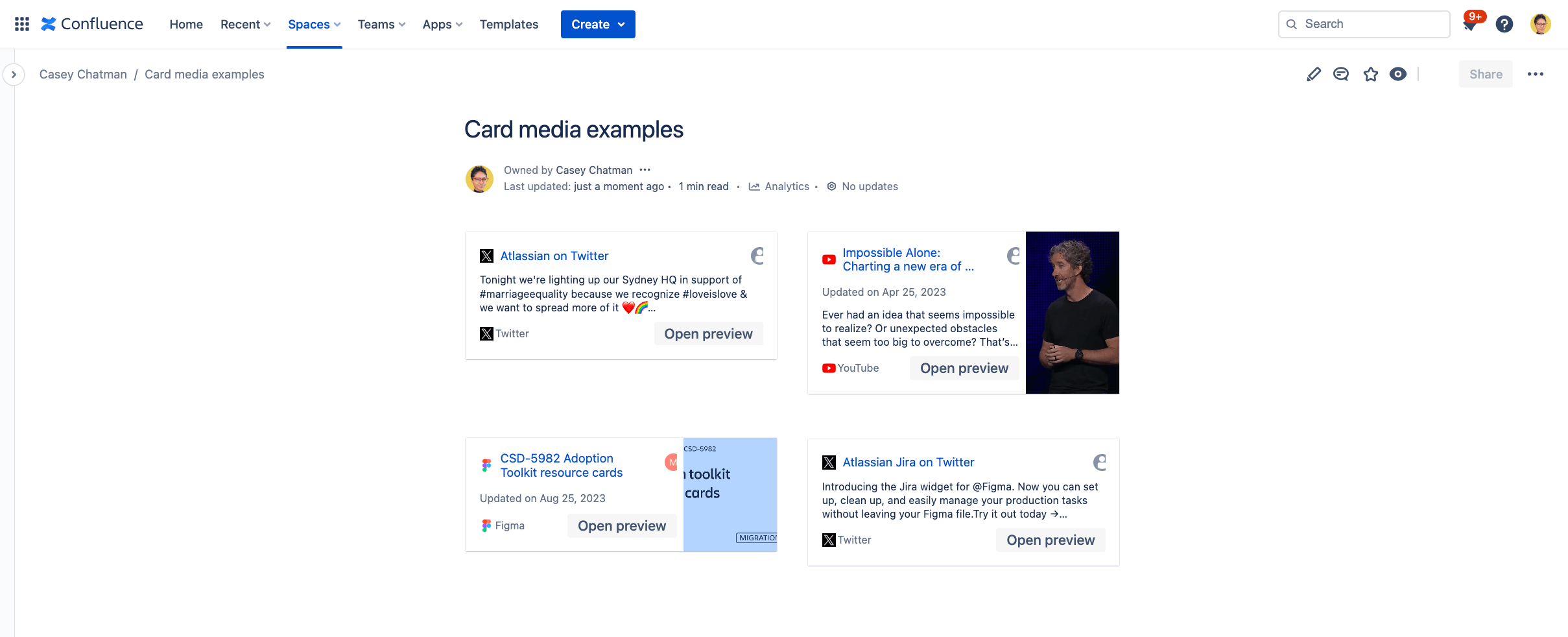
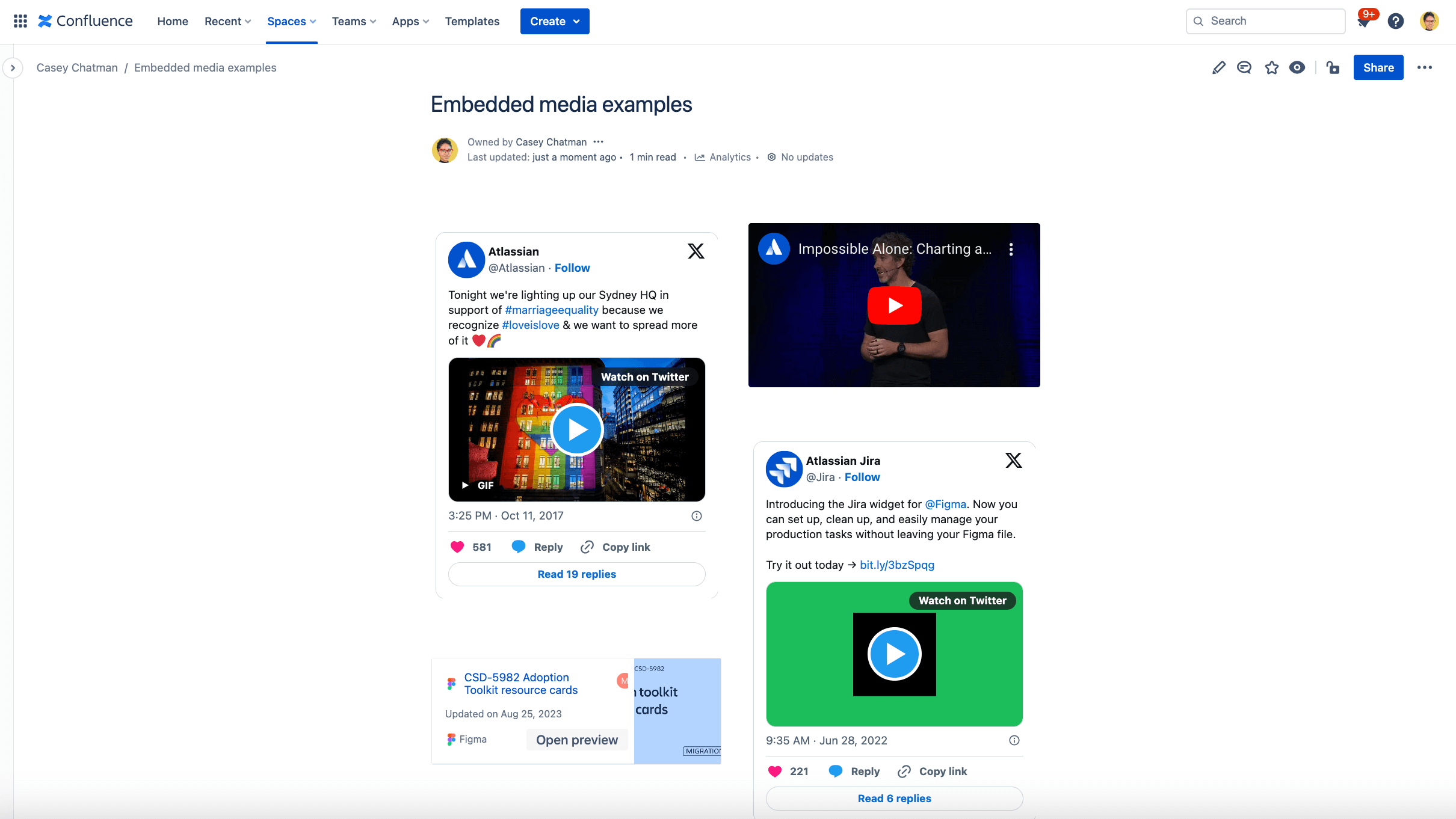
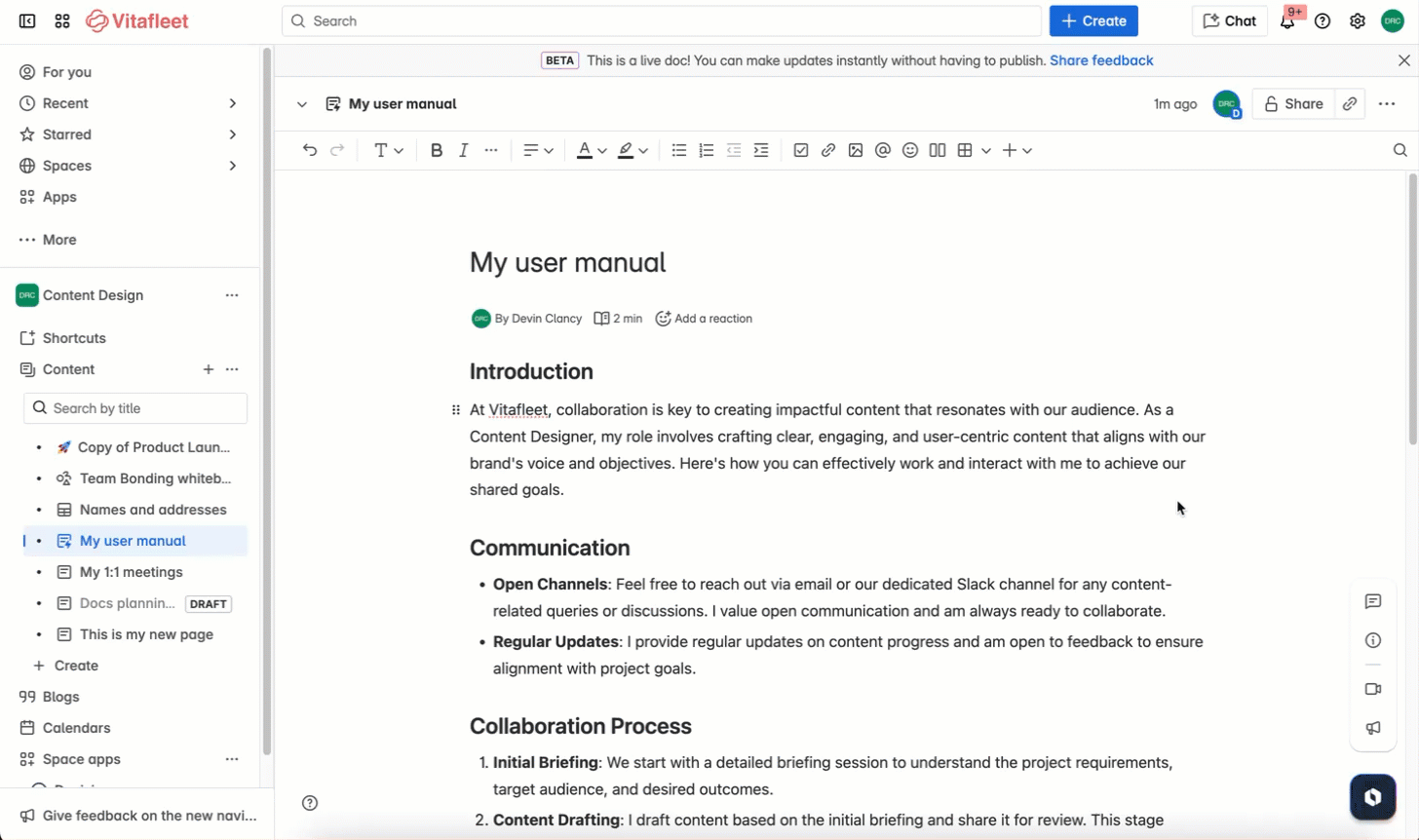
To learn more about your options for hyperlinking content, read about Smart Links.
Search
Search in cloud is faster, more relevant, and flexible. If you are on a Paid subscription (Standard, Premium, Enterprise), your search is powered by Rovo AI once it is enabled, which enhances results with:
- Cross-app results from tools like Jira, Google Drive, and Slack
- AI-generated answers to natural language questions, complete with cited sources
Additional content types
Beyond pages and blogs, Confluence Cloud supports multimodal content creation to suit a variety of workflows:
- Live doc: Collaborate in real time—no need to publish.
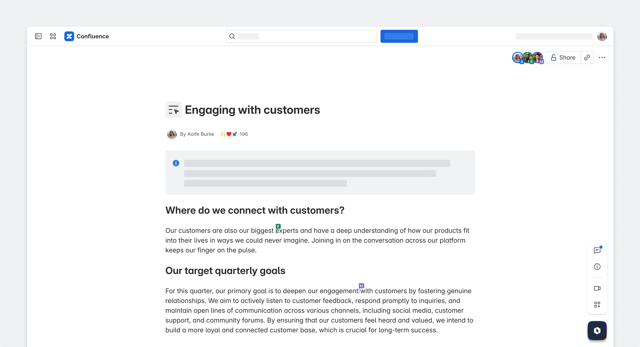
- Whiteboard: A digital whiteboard for brainstorming, diagramming, and mapping ideas visually.
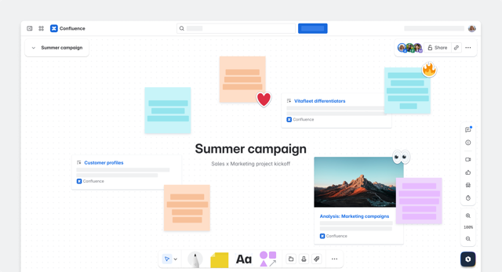
- Database: Organize structured information in a customizable, filterable view. Track deliverables, manage resources, and centralize knowledge from across tools.
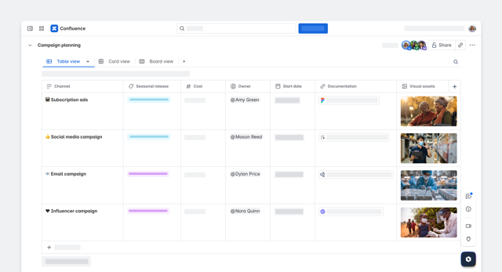
- Folders: Add folders to your space to keep related work together. Think of folders as simple containers that are used as a place to store all related work.
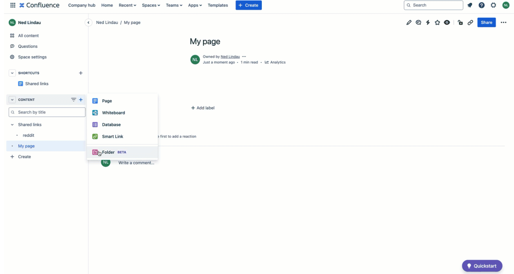
AI capabilities
With Rovo built-in, Confluence Cloud makes it easier and faster to share knowledge and collaborate across teams.
- Find information faster: Search across the Confluence knowledge base and ask Rovo Chat questions in plain language to surface pages and information within seconds.
- Automate routine work: Use out-of-the-box agents to draft content, manage tasks, and streamline workflows.
- AI-assisted editing: Highlight text in a Confluence page, then invoke the AI editor via ‘Improve writing’ to quickly change tone, correct grammar, and add polish to your written content.
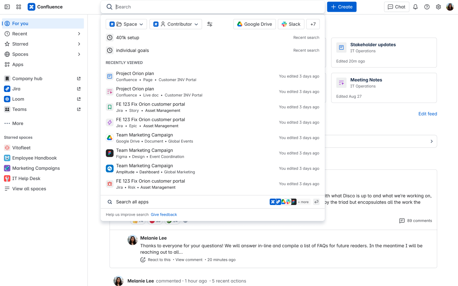
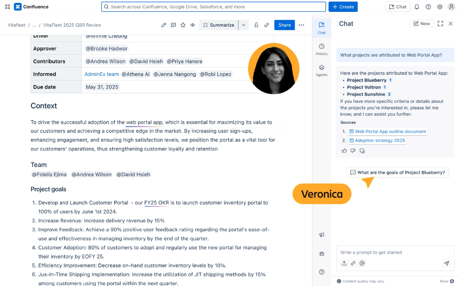
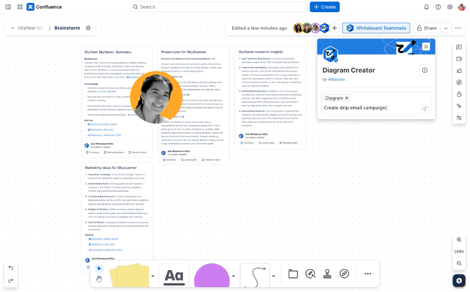
Company Hub
Available on Confluence Cloud Premium and Enterprise, Company Hub is a customizable central homepage where your entire organization can access key updates, announcements, and verified resources.
By default, only app and site admins can see and set up the Hub, but they can choose to delegate visibility and editing access to other trusted users.
To get started, eligible users can find Company Hub in the left sidebar and begin customizing it to reflect your company’s needs.
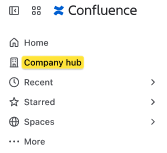
Governance in cloud
As your organization embraces the transition from data center to cloud, naturally, you may be curious about the nuances of your new cloud environment and how your admin responsibilities will shift accordingly. This section will go over key responsibilities, permissions, and workflows associated with each Atlassian admin role in data center vs. cloud apps, highlighting each role’s impact on tool configuration, user management, security, and overall governance in cloud.
Admin roles in data center
Admin roles allow organizations to delegate different responsibilities among many admins instead of relying on just one person. What you can access and configure is determined by the type of admin you are. In data center, there are three admin roles: System admin, Product admin, and Space admin. See below how these roles relate to admin roles in cloud:
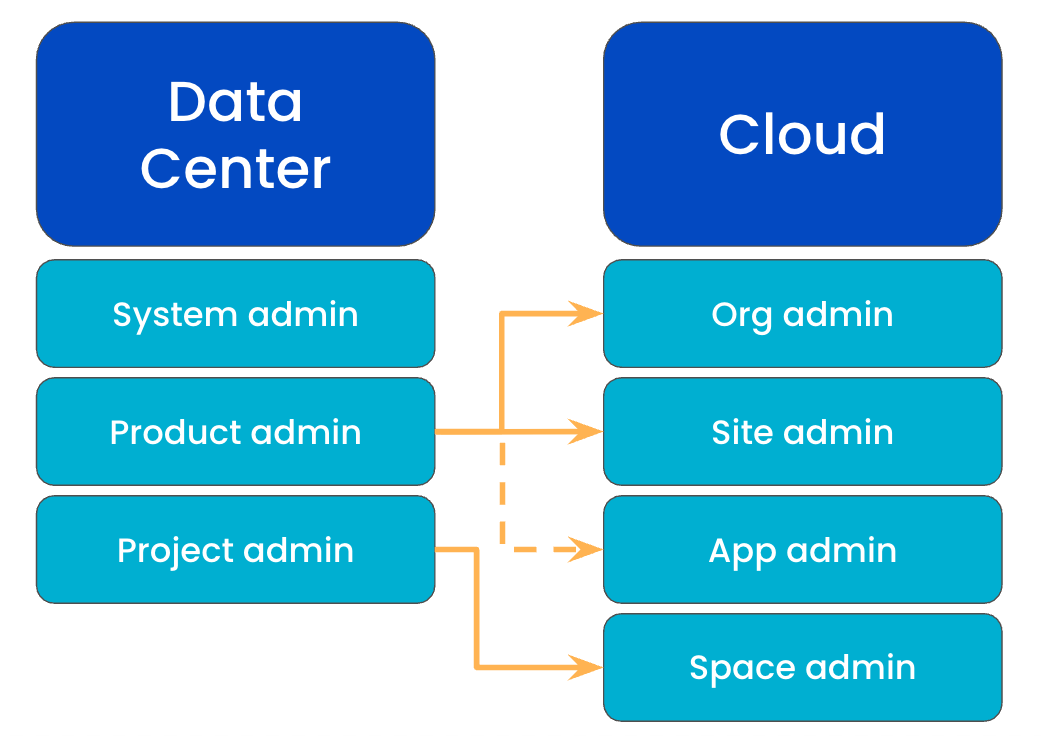
System admin
The system admin is responsible for managing the physical servers, hardware, and planned/unplanned downtime. They have the same permissions as the product admin plus access to the hardware, servers, and the ability to modify all system settings.
Product admin (or Jira admin)
The product admin can modify most of the system settings in the app(s) they administer. They can also simultaneously serve as the system admin, as both admin roles have overlapping permissions. Product admins can assign permissions via group control and are able to create new spaces, fields, and users and change workflows.
Project admin
The project admin is assigned to a single person by role assignment in the respective project. They have the capability to modify various configurations of the project.
Extended project administration rights are also available to project admins and allow them to adapt workflows and screens under certain conditions. For example, they can add a status if it is already contained in an active app instance. New statuses cannot be created, and existing statuses cannot be edited. The project admin can also add, rearrange, or remove, but not create, custom fields.
Admin roles in cloud
Similar to data center, there are several types of admin roles in cloud and it’s possible to have multiple admin roles at the same time. The admin roles you can have and assign to other members within your organization depend on whether you are using the original user management experience or the centralized user management experience within Atlassian Administration (admin.atlassian.com).
TIP: Atlassian Administration (admin.atlassian.com) is a centralized app for managing your cloud organization - from managing user access and adding services to implementing robust security policies and tracking usage and billing, Atlassian Administration brings all of your administrative responsibilities together in one place.
NOTE: This section only outlines admin roles granted through Atlassian Administration. If you want to know more about other admins, read the documentation for:
Which user management experience do you have?
To check, go to your organization at admin.atlassian.com and select Directory. If the Users and Groups lists are found here, then you are using the centralized user management.
As a site administrator or organization admin, Users is found under Product site.
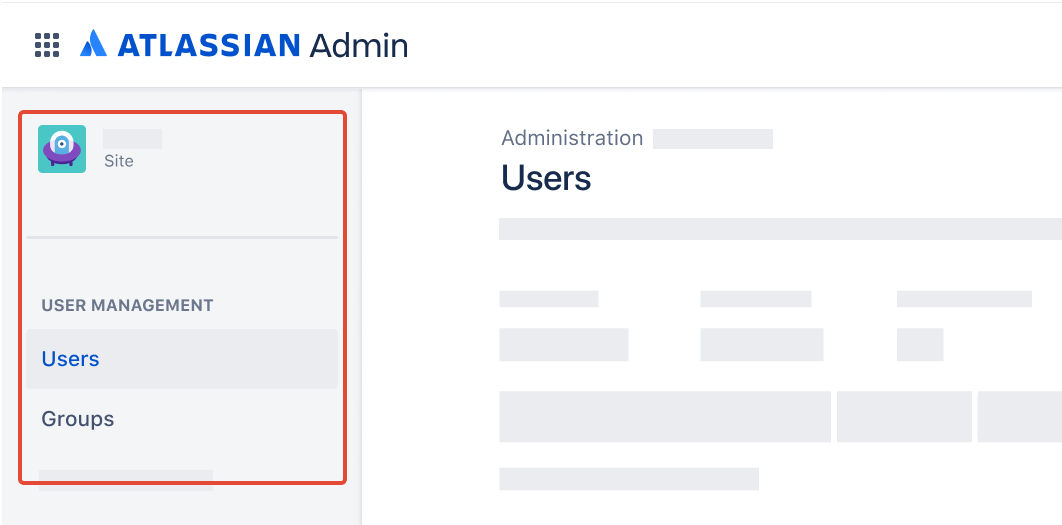
As an organization admin, Users is found under Directory tab.
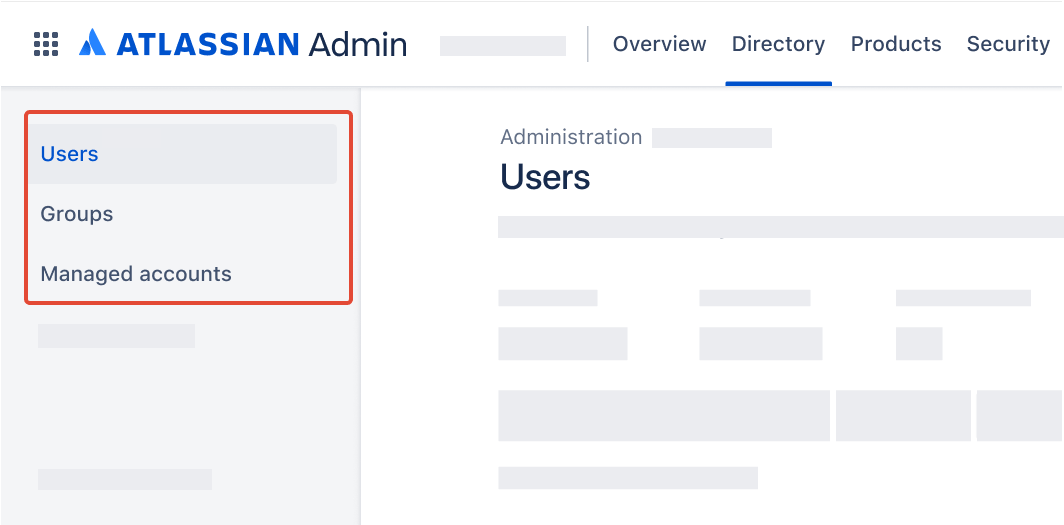
Admin roles available in both the original and centralized user management experiences
Organization admin
When you create an organization, you automatically become an organization (or org) admin - the highest level of admin - and can complete any administrative task in Atlassian Administration. We recommend you have more than one org admin in case one account is lost or compromised.
Site admin
For the original user management experience, a site admin manages the users, groups, and administration settings of the site they’ve been assigned to (as well as any apps that sit within this site). Site admins have access to any content within their assigned site. The role allows limited access to manage billing.
For the centralized user management experience, a site admin can complete tasks related to the specific site they are administering including adding new apps to the site and managing apps installed on the site, and have limited access to manage billing. Site admins in the centralized user management experience cannot manage users or groups.
Read this to learn more about the site admin differences.
App admin
An app admin can manage administration settings for a specific app. They don’t have access to Atlassian Administration. With the exception of Jira admins, app admins can access the content within the app they administer. It’s possible to be an app admin for one or more Atlassian apps.
Space admin
A space admin can manage administration settings for a specific space. They don’t have access to global or site-wide administration. Rather, space admins control the permissions, content visibility, and configuration within their scope, such as assigning user or group access, updating settings, or customizing look and feel. They cannot view locked content or override global defaults. It’s possible to be a space admin for one or more spaces.
User access admin
Unlike an organization admin, a user access admin has limited access to Atlassian Administration. Their main task is to manage user access to the apps they administer. For example, an organization might have a user access admin that manages app access for Confluence, and another user access admin managing app access for Jira.
A user access admin can be assigned to one or more apps, but can’t log in or use those apps. This means user access admins won’t count as billable users for the apps they administer, unless they’re granted an additional role that gives access to that app.
TIP: Read this article to learn which features are available to each admin role in Atlassian Administration.
Keep governance processes and practices up to date
To effectively manage admin access requests, minimize unauthorized changes, and maintain a compliant administrative environment, consider establishing an approval process for users seeking org, user, app, and space administrative permissions. You can streamline this process by creating a dedicated request type or a user-friendly form where users can provide essential details about the access they require and the purpose behind their request.
Within Atlassian Administration, org admins can also configure user access settings. This allows admins to specify domains that can gain access to apps without an invitation, or with an admin’s approval. When configured to require approval, users from that domain can request access to an app and include more details about their request for admins to then approve or deny.
By implementing this process, admins like yourself can stay in control and ensure adherence to your organization's app governance practices.
To keep up with evolving needs, be sure to regularly review and update your app governance policies, scheduling periodic check-ins (e.g., annually or bi-annually) to align them with your organization's growth and changing requirements.
When embarking on a space to review and enhance governance practices, Atlassian provides valuable resources to support you along the way. Check out the following plays from our Team playbook to align with internal stakeholders who share cloud governance responsibilities and may be impacted by changes:
To capture and document discussions and agreements made during the process, ensure clarity, consensus, and success in governance-related endeavors, use the following Confluence templates:
Supporting your users
In the first two weeks following the launch of Atlassian Cloud, you may notice a dip in productivity among users as they adjust. Help keep productivity high by preparing additional support you can offer during that time. For example, you might want to consider:
- Creating a Help Center: Post-migration, users need to know where to raise bugs, ask questions, and share feedback. You can quickly set up a team-managed Jira Service Management project with a knowledge base in Confluence for your “how to” materials. Alternatively, create a ‘migration’ request type in your service desk system of choice to receive and process this type of request and archive the space/request type when the users have settled comfortably in the cloud.
- Hosting drop-in training sessions: Champions, space admins, and teammates who were involved in UAT, can schedule open drop-in sessions (via Zoom/MS Teams) for a few hours every day in the first week after the migration has taken place. Users can join on ad hoc basis to ask questions or raise urgent issues. These sessions can help minimize the number of support tickets raised.
- Staffing Rapid Response channels: Creating dedicated channels in MS Teams or any chat platform your users communicate in internally can come in handy. Organizing a roster of Support agents and Champions who can reply to questions posted in the channel on-the-go is advised.
- Administering surveys: Surveys are a powerful tool to capture and aggregate team sentiment, which can help bubble up improvement opportunities and/or success stories and be used to report to the leadership team. Simple surveys distributed among users at various intervals can reveal changes in sentiment and progression over time.
TIP: Because all self-managed instances are unique - version-specific and customized with the help of Atlassian Marketplace apps - we recommend that all differences and gaps discovered by testers during cloud UAT testing are noted down in an FAQ page which can be shared with users or easily referred to post migration when similar questions come up.
Conclusion
While we hope this guide has provided you with a helpful overview of the key changes you and your users can expect when transitioning to Atlassian Cloud, there’s no single resource to rely on when it comes to getting users started with a new app and ensuring lasting adoption. To be successful, it will take a combination of the right materials (including this guide, the resources linked throughout, and materials you create on your own) shared with the right audience, at the right time, and in the right way. If you need more support thinking through your change management plan, please read Atlassian's guide to adoption and change management. Our support teams are always here to help if you need further support.
